The Whistler Group SC01 200CH HANDHELD RADIO SCANNER User Manual
The Whistler Group 200CH HANDHELD RADIO SCANNER
User Manual
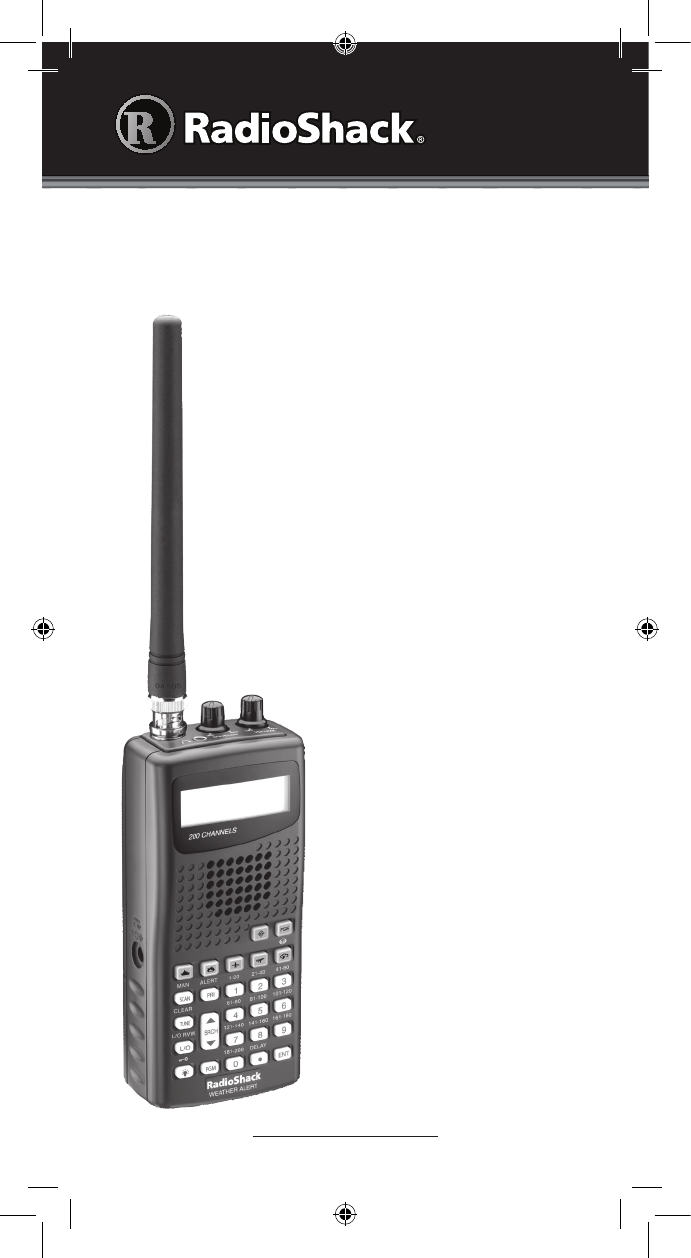
User’s Guide
PRO-649
Thank you for purchasing your
Handheld Radio Scanner from
RadioShack. Please read this user’s
guide before installing, setting up,
and using your new scanner
Handheld Radio Scanner
www.radioshack.com
Package Contents
Scanner
Antenna
Belt Clip
User’s Guide
Quick Start Guide
Alkaline Battery Holder
Rechargeable Battery
Holder

2
Contents
Features ................................................... 4
Understanding Your Scanner .............................5
Channel Storage Banks ...................................6
Service Banks ..................................................6
Preprogrammed Service Bank Frequencies ......6
Marine Service Bank ........................................6
Fire/Police Service Bank ..................................8
Aircraft Service Bank .......................................9
Ham Amateur Radio Service Bank ..................9
Weather Channels ...........................................9
Understanding the Keypad .............................10
Understanding the Display ..............................12
Additional Display Messages ........................13
Sub Bank Messages ......................................13
Setup ..................................................... 14
Power Sources .................................................14
Using Batteries ..............................................14
Charging Rechargeable Batteries .................16
Using External Power ....................................17
Connecting the Antenna .................................18
Connecting an Outdoor Antenna .................18
Connecting Headphones ................................18
Connecting an Extension Speaker ................19
Attaching/Removing the Belt Clip ................19
Basic Operation ..................................... 20
Turning on the Scanner and Setting Squelch .....20
Programming Known Frequencies into
Channels ..........................................................20
Searching for Active Frequencies ...................21
Tune Search ...................................................21
Service Bank Search ......................................22
Signal Stalker II Search ..................................22
Storing Found Frequencies into Channels ......23
Scanning the Stored Channels ........................24
Turning Channel-Storage Banks On and Off .....24

3
Monitoring a Stored Channel ..........................25
Clearing a Stored Channel ............................25
Listening to the Marine Bank ..........................25
Weather Features .................................. 26
Listening to a Weather Channel ......................26
Weather Alerts ................................................26
Receiving All Weather Alerts ........................26
Receiving Alerts for Specific Areas ...............27
About SAME Signals ...................................27
SAME Standby Mode ..................................27
Skywarn .........................................................28
Settings .................................................. 29
Setting Delay ...................................................29
Locking Out Channels and Frequencies .........29
Reviewing and Removing Lock-outs .............30
Stored Channels ..........................................30
Marine Service Bank ....................................30
Other Service Banks and Signal Stalker II ...30
Removing Lock-outs from All Frequencies
in a Service Bank .........................................31
Using Priority ...................................................31
Using the Display Backlight.............................32
Turning the Key Tone On and Off ...................32
Using the Key Lock ..........................................32
Additional Information ........................... 33
Cloning the Programmed Data .......................33
Programming with a Personal Computer ........33
Initializing the Scanner ....................................33
Troubleshooting ..............................................34
Birdie Frequencies ...........................................35
FCC Notice ......................................................35
Scanning Legally..............................................36
Care .................................................................37
Service and Repair ..........................................37
Specifications ..................................................37
Limited Warranty .............................................39
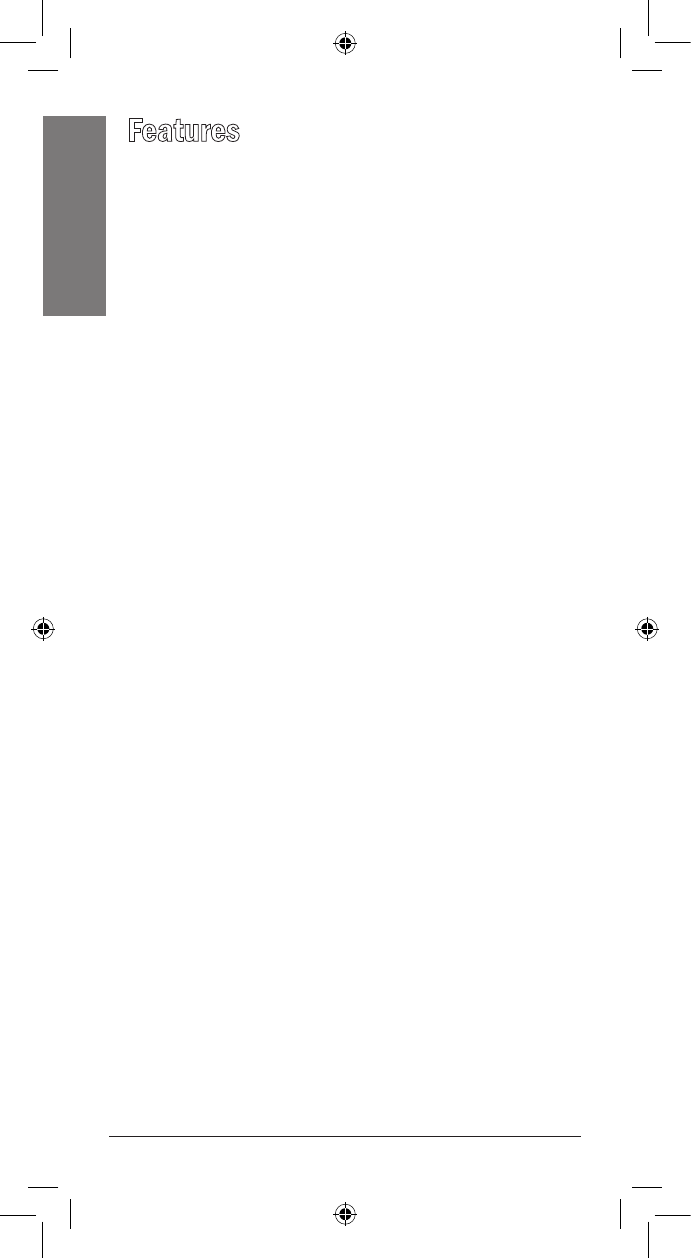
4
Features
Features
Your new PRO-649 Handheld Scanner lets you scan
conventional transmissions and is preprogrammed with
search banks of the most common frequencies used
by public service agencies. Service Banks are accessed
by pressing a one-touch search key—no complicated
programming required.
Your new scanner gives you direct access to over 25,000
frequencies, including those used by police and fire
departments, ambulance services, aircraft, and amateur
radio services.
Your PRO-649 scanner also has these special
features:
Signal Stalker II – a powerful tool to rapidly detect,
monitor, and store frequencies from nearby radio
transmissions.
Service Banks – easily locate types of calls by searching
preprogrammed frequencies in separate marine, fire/
police, aircraft, ham, and weather banks.
Display Backlight – makes the display easy to read in
low-light situations.
Lock-out Function – skip over specified channels or
frequencies when scanning or searching.
Ten Channel-Storage Banks – group and store 20
channels in each bank (200 total channels).
Tune – tune to new and unlisted frequencies starting
from a specified frequency.
SAME/FIPS Weather Alert – displays the weather
event and sounds an alert for the specific cities or
counties you choose.
Memory Backup – frequencies remain stored in
memory for an extended time even without batteries.
Scan Delay – delays scanning for two seconds before
moving to another channel in order to hear replies.
Priority Channel – set the scanner to check one
channel every two seconds while scanning.
Data Cloning – transfer the programmed data to
another PRO-649 scanner.
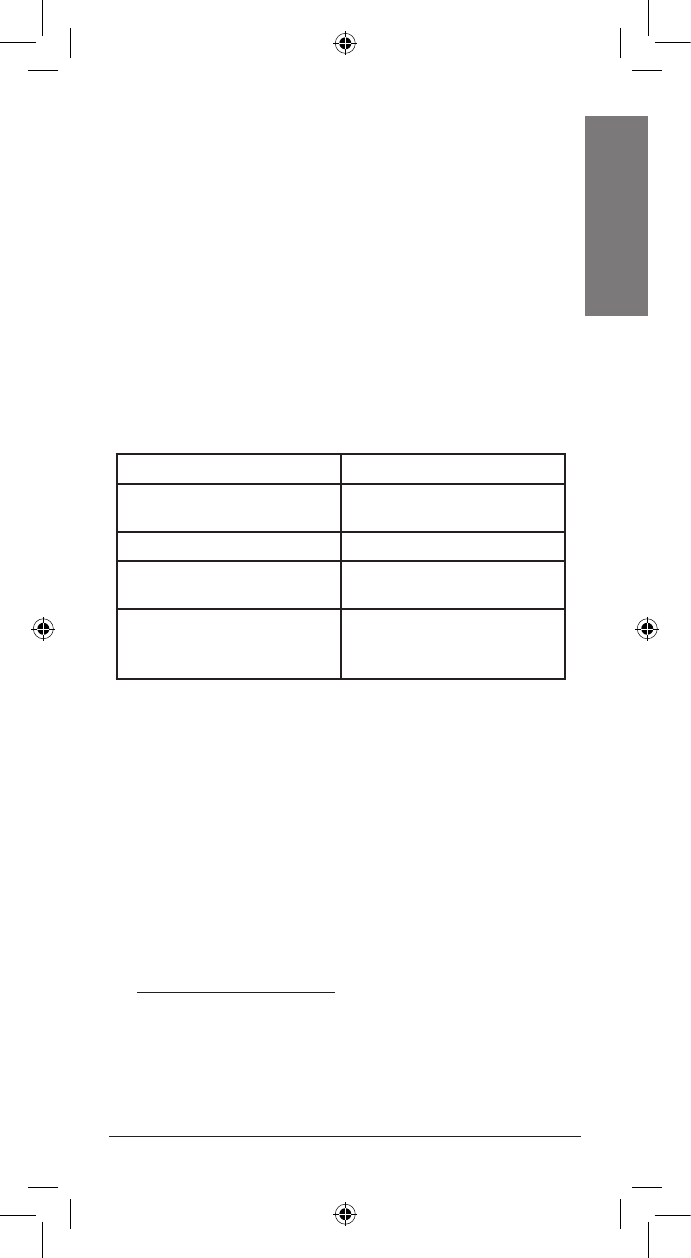
5
Features
Key Lock – lock the scanner’s keys to help prevent
accidentally changing the scanner’s programming.
Liquid-Crystal Display – easy to view and change
programming information.
Flexible Antenna with BNC Connector – provides
good reception of strong local signals. You can also
connect an external antenna for improved reception of
distant or weak signals.
Three Power Options – power the scanner using
batteries (rechargeable or non-rechargeable), external
AC power (using an AC adapter, not supplied), or DC
power (using a DC adapter, not supplied).
Your PRO-649 scanner can receive these bands:
Frequency Range Types of Transmissions
29–54 MHz 10-Meter Ham, VHF Lo,
6-Meter Ham
108–136.9875 MHz Aircraft
137–174 MHz Military Land Mobile, 2-
Meter Ham, VHF Hi
380–512 MHz UHF Aircraft, Federal
Government, 70-cm Ham,
UHF Standard, UHF “T”
Note: See “Specifications” on page 37 for more
information about frequency steps.
Understanding Your Scanner
Once you understand a few simple terms used in this
manual and familiarize yourself with your scanner’s
features, you can put the scanner to work for you.
Simply determine the type of communications you want
to receive, then set the scanner to scan them.
A frequency is the receiving signal location (expressed
in kHz or MHz). To find active frequencies, use the
search function or consult an online resource such
as www.radioreference.com. You can also search the
Service Banks, which are preset groups of frequencies
categorized by type of service.
When you find a frequency, you can store it into a
programmable memory location called a channel,
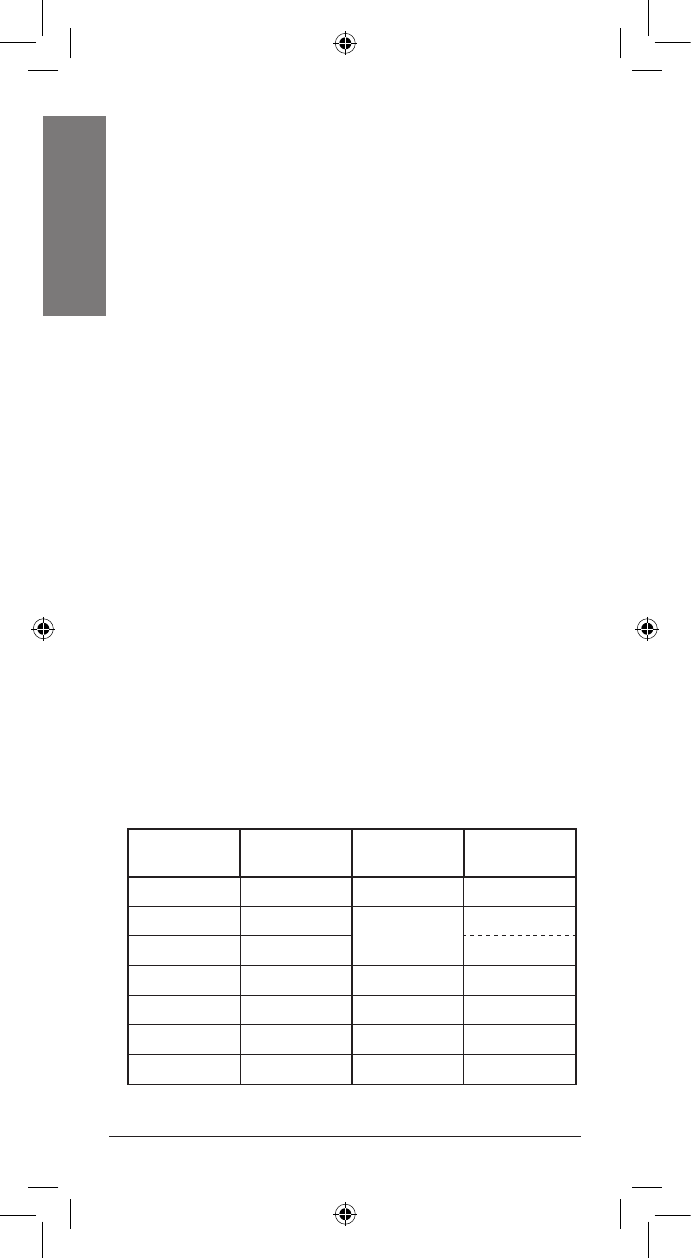
6
Features
which is grouped with other channels in a channel-
storage bank. You can then scan the channel-storage
banks to see if there is activity on the frequencies stored
there. Each time the scanner finds an active frequency, it
stays on that channel until the transmission ends.
Channel Storage Banks
To make it easier to identify and select the channels you
want to listen to, your scanner divides the channels into
10 banks (1 to 10) with 20 channels each, for a total of
200 channels. You can use each channel-storage bank
to group frequencies, such as those used by the police
department, fire department, ambulance services, or
aircraft.
For example, you could program the frequencies used
by your local police department starting with Channel
1 (the first channel in bank 1) and program the fire
department frequencies starting with Channel 21 (the
first channel in bank 2).
Service Banks
The scanner is preprogrammed with the frequencies
allocated to marine, fire/police, aircraft, ham radio, and
weather services. This is handy for quickly finding active
frequencies instead of searching through an entire bank
(see “Service Bank Search” on page 22).
Preprogrammed Service Bank
Frequencies
Marine Service Bank
Channel Frequency
(MHz) Channel Frequency
(MHz)
01 156.0500 63 156.1750
02 156.2500 64 156.2250
06 156.3000 160.8250
07 156.3500 65 156.2750
08 156.4000 66 156.3250
09 156.4500 67 156.3750
10 156.5000 68 156.4250
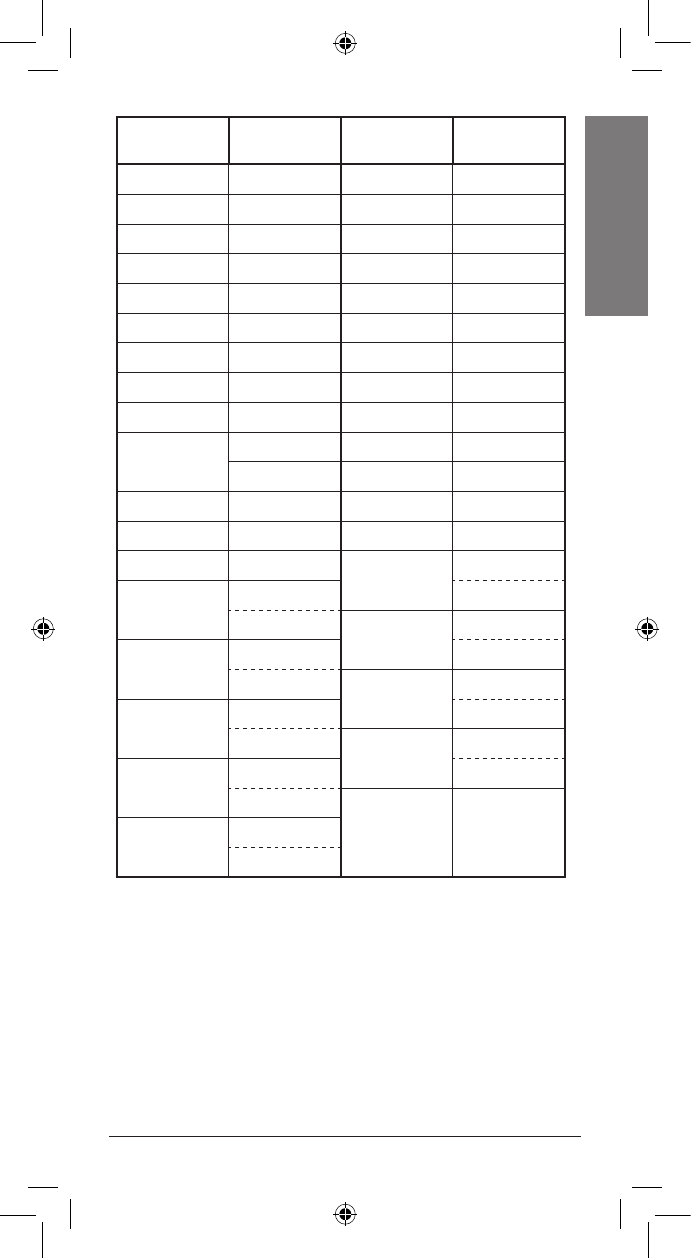
7
Features
Channel Frequency
(MHz) Channel Frequency
(MHz)
11 156.5500 69 156.4750
12 156.6000 70 156.5250
13 156.6500 71 156.5750
14 156.7000 72 156.6250
15 156.7500 73 156.6750
16 156.8000 74 156.7250
17 156.8500 77 156.8750
18 156.9000 78 156.9250
19 156.9500 79 156.9750
20 157.0000 80 157.0250
161.6000 81 157.0750
21 157.0500 82 157.1250
22 157.1000 83 157.1750
23 157.1500 84 157.2250
24 157.2000 161.8250
161.8000 85 157.2750
25 157.2500 161.8750
161.8500 86 157.3250
26 157.3000 161.9250
161.9000 87 157.3750
27 157.3500 161.9750
161.9500 88 157.4250
28 157.4000
162.0000
n Note: Both frequencies (transmission and reception)
are shown for marine channels used for duplex
transmission.
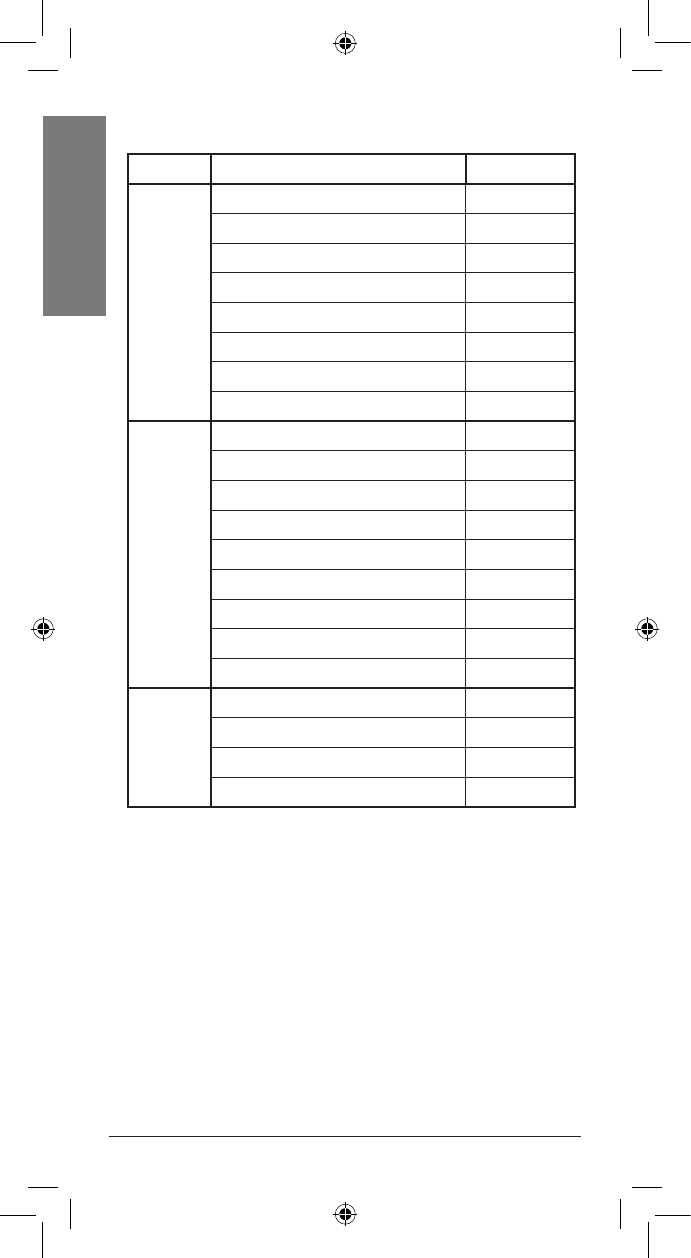
8
Features
Fire/Police Service Bank
Group Frequency Range (MHz) Step (kHz)
1 33.420-33.980 20
37.020-37.420 20
39.020-39.980 20
42.020-42.940 20
44.620-45.860 40
45.880 -
45.900-46.060 40
46.080-46.500 20
2 153.770-154.130 60
154.145-154.445 15
154.650-154.950 15
155.010-155.370 60
155.415-155.700 15
155.730-156.210 60
158.730-159.210 60
166.250 -
170.150 -
3 453.0375-453.9625 12.5
458.0375-458.9625 12.5
460.0125-460.6375 12.5
465.0125-465.6375 12.5
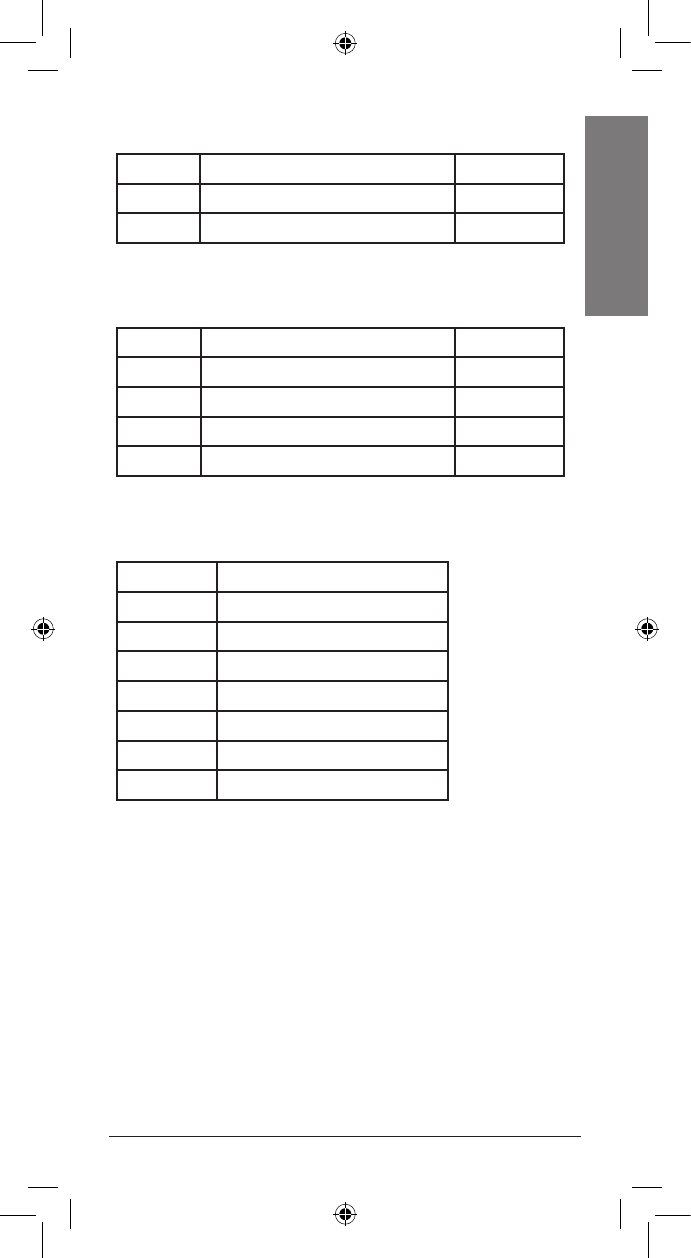
9
Features
Aircraft Service Bank
Group Frequency Range (MHz) Step (kHz)
1 108.000-118.000 12.5
2 118.0125-136.9875 12.5
Ham Amateur Radio Service Bank
Group Frequency Range (MHz) Step (kHz)
1 29.000-29.700 5
2 50.000-54.000 5
3 144.000-148.000 5
4 420.000-450.000 12.5
Weather Channels
Channel Frequency (MHz)
1 162.400
2 162.425
3 162.450
4 162.475
5 162.500
6 162.525
7 162.550
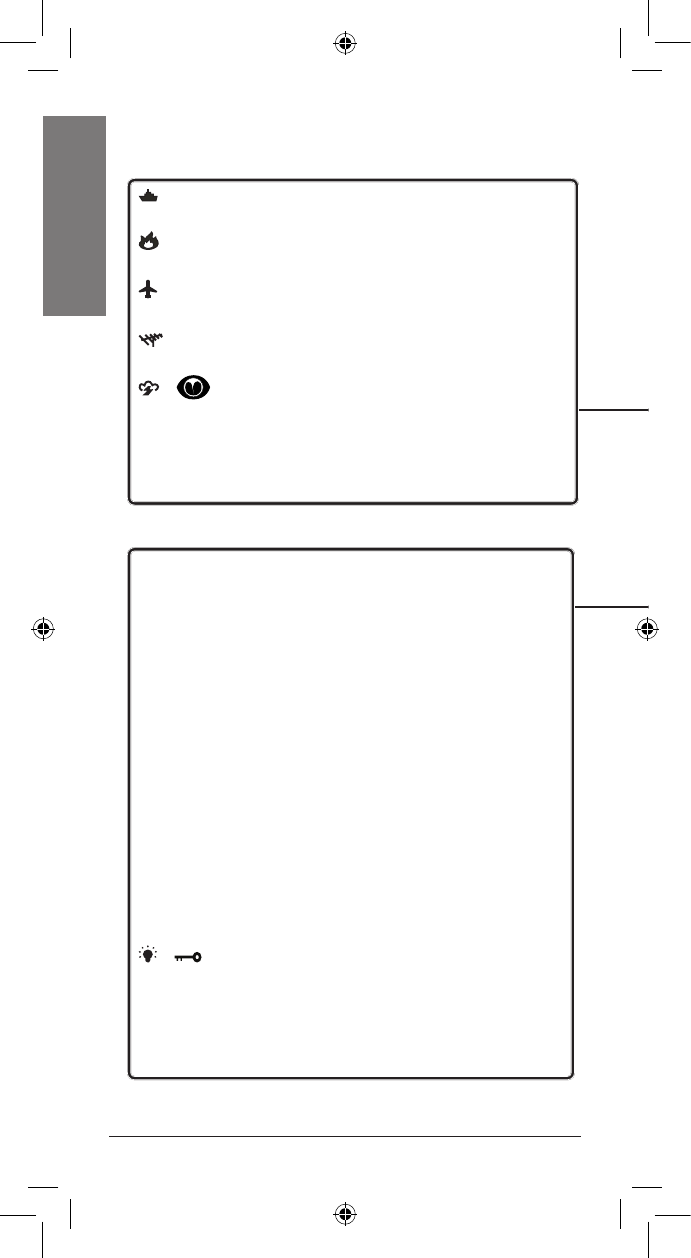
10
Features
Understanding the Keypad
(Marine)
Search the preprogrammed marine bank.
(Fire Department/Police Department)
Search the preprogrammed fire/police bank.
(Aircraft)
Search the preprogrammed aircraft bank.
(HAM)
Search the preprogrammed amateur radio bank.
/ (Weather / Skywarn)
Search the seven preprogrammed weather channels.
Press and hold to jump to the Skywarn channel
(channel 200). You must first program your local
Skywarn frequency into channel 200 (see page 20).
-
-
SCAN / MAN (Manual)
Enter Scan mode to scan programmed channels.
Enter Manual mode to stop scanning, directly enter
a channel number, or monitor a single channel.
PRI / ALERT
Enable and disable the priority feature.
Enable and disable SAME standby mode when
monitoring a weather channel.
TUNE / CLEAR
Enter Tune search.
Clear an incorrect entry.
e d
Select the direction for searching and scanning.
L/O
/
L/O RVW
Lock-out selected channels or frequencies.
Review locked-out frequencies.
/
Turn the backlight on and off.
Press and hold to lock and unlock the keypad.
PGM
Program frequencies into channels.
-
-
-
-
-
-
-
-
-
-
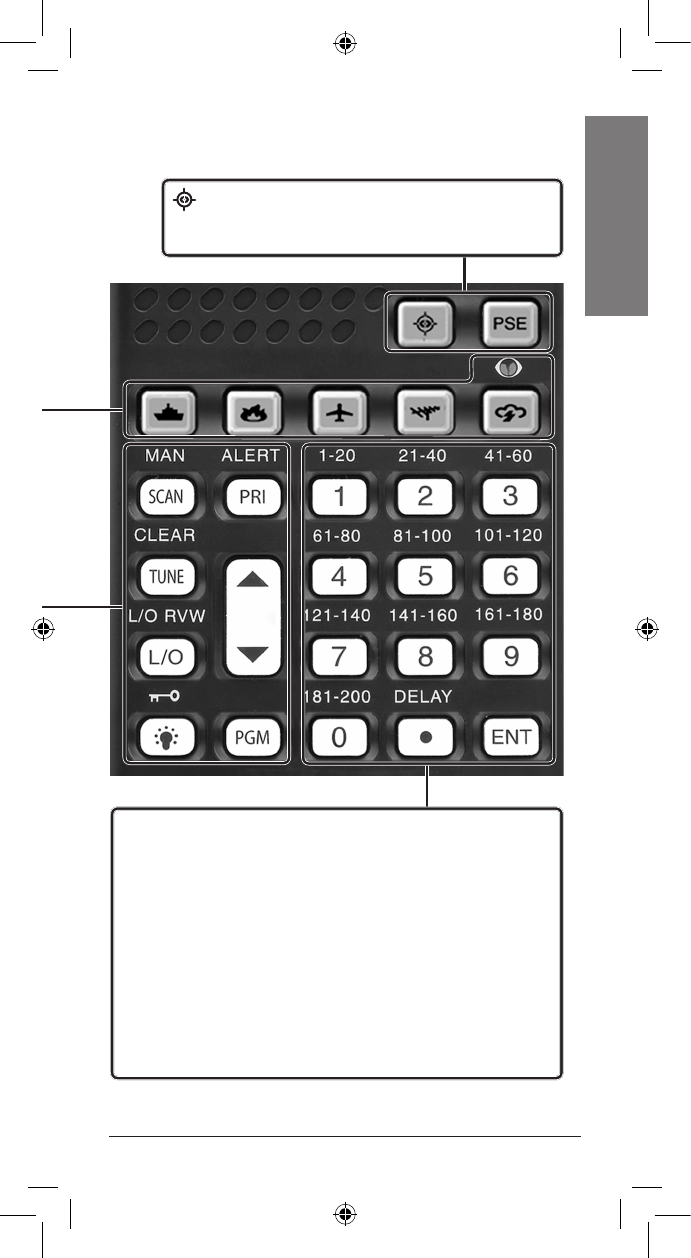
11
Features
0–9
Input a number when entering frequencies and
selecting banks (0 selects bank 10).
The range of numbers above the key (1–20, 21–40,
41-60, etc.) indicates the channels stored in that bank.
• / DELAY
Input a decimal point when entering frequencies.
Program a two-second delay for the selected
channel.
ENT (Enter)
Complete the entry of frequencies.
-
-
-
-
(Signal Stalker II)
Activate the Signal
Stalker II function.
PSE (Pause)
Stop and restart
a search or tune.
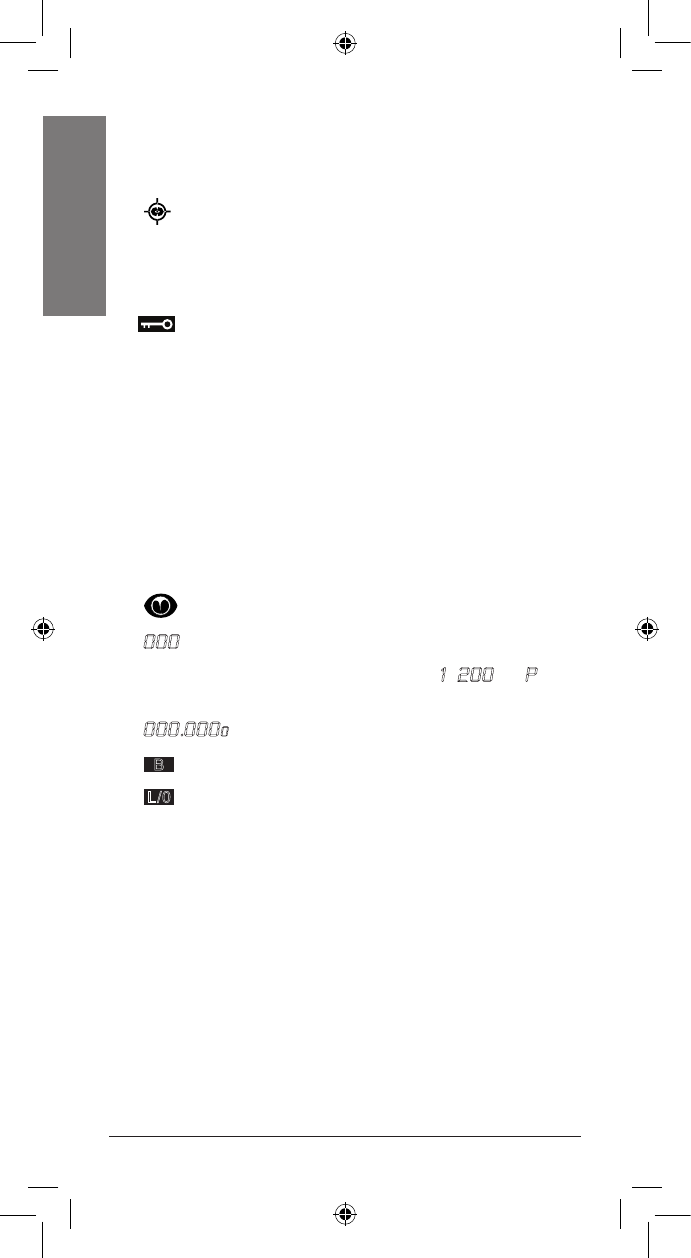
12
Features
Understanding the Display
Row 1
– Signal Stalker II search is active.
BANK – Appears with numbers (1–10) to indicate
the scan bank. The bar under the bank number shows
banks that are turned on for scanning.
– Keypad locked.
Row 2
WX – Searching weather channels.
MAR – Searching the marine bank.
FD/PD – Searching the fire/police bank.
AIR – Searching the aircraft bank.
HAM – Searching the amateur radio bank.
Row 3
– Skywarn channel active.
000
– Channel number the scanner is tuned to.
CH – Appears with channel number (
1
–
200
) or
P
(priority channel).
000.0000
– Frequency the scanner is tuned to.
B – Batteries are low.
L/0 – A locked out channel/frequency is manually
selected or reviewed.
Row 4
e d (Up/Down) – Search or scan direction.
SRCH – Searching a service bank.
SCAN – Scan mode.
MAN – Manual mode.
PGM – Program mode.
PRI – Priority feature is active.
DLY – Two-second delay is active.
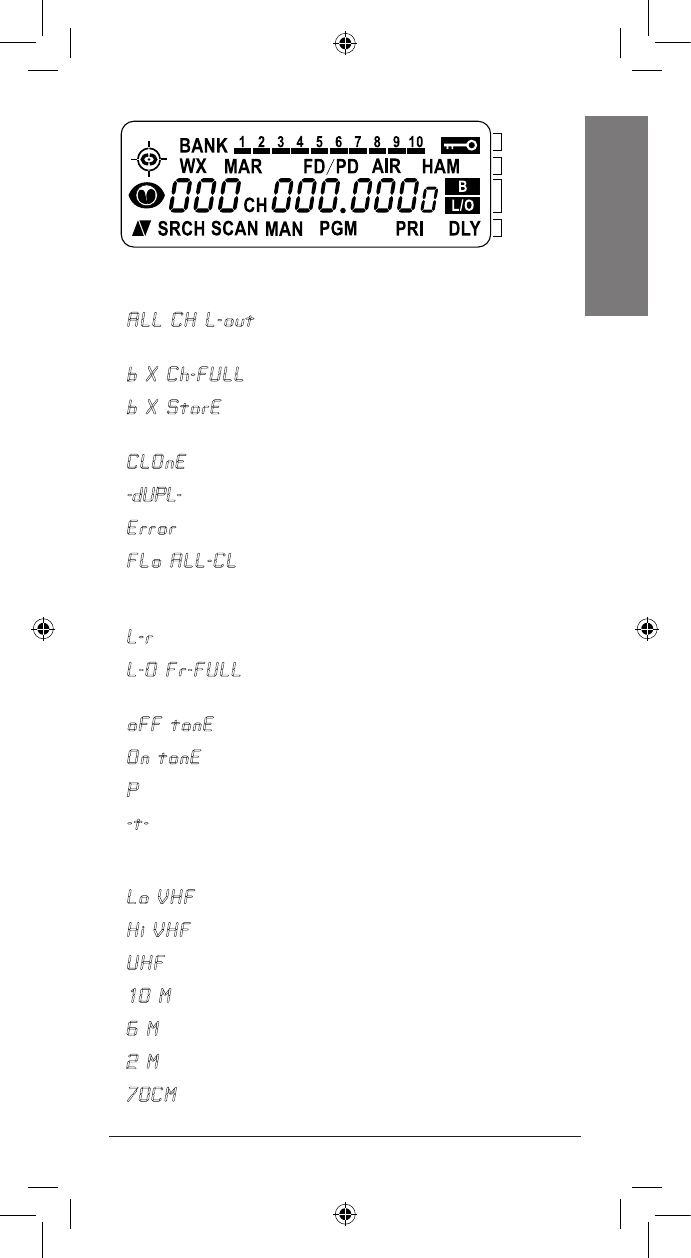
13
Features
Row 1
Row 2
Row 3
Row 4
Additional Display Messages
ALL CH L-out
– All channels locked out during scan
or marine band search .
b X Ch-FULL
– All displayed bank channels are full.
b X StorE
– Frequency programmed into displayed
bank’s channel.
CLOnE
– Clone mode.
-dUPL-
– Frequency is already stored in another channel.
Error
– Entry error.
FLo ALL-CL
– All the locked-out frequencies
removed during a FD/PD, AIRCRAFT, HAM, or Signal
Stalker II search.
L-r
– Review the locked-out frequencies.
L-O Fr-FULL
– Maximum of 50 frequencies already
locked out.
oFF tonE
– Key tone deactivated.
On tonE
– Key tone activated.
P
– Scanner is tuned to the priority channel.
-t-
– Tune mode.
Sub Bank Messages
Lo VHF
– Sub-bank 1 of the fire/police bank.
Hi VHF
– Sub-bank 2 of the fire/police bank.
UHF
– Sub-bank 3 of the fire/police bank.
10 M
– Sub-bank 1 of the HAM bank.
6 M
– Sub-bank 2 of the HAM bank.
2 M
– Sub-bank 3 of the HAM bank.
70CM
– Sub-bank 4 of the HAM bank.

14
Setup
Setup
Power Sources
You can power your scanner from one of three sources:
• Rechargeable or non-rechargeable batteries (not
supplied).
• Standard AC power using an optional AC adapter
(not supplied).
• Vehicle power using an optional DC adapter (not
supplied).
Using Batteries
You can power the scanner with four AA batteries
(not supplied). For the longest operation and best
performance, we recommend alkaline batteries. If you
use rechargeable batteries, we recommend nickel-metal
hydride (Ni-MH) batteries.
Use the black battery holder for non-rechargeable
batteries. Use the yellow holder for rechargeable
batteries.
w Warning: Never install non-rechargeable batteries
in the rechargeable yellow battery holder. Non-
rechargeable batteries can get hot or explode if you try
to recharge them.
To install batteries
1. Slide open the battery compartment cover on the
back of the scanner.
2. Place 4 AA batteries into the correct battery holder
matching polarity symbols (+ / –):
Black – Alkaline (non-rechargeable)
Yellow – Rechargeable Ni-MH or Ni-Cd
3. Place the battery holder into the battery
compartment. The battery holder fits only one way.
Do not force it.
4. Replace the cover.
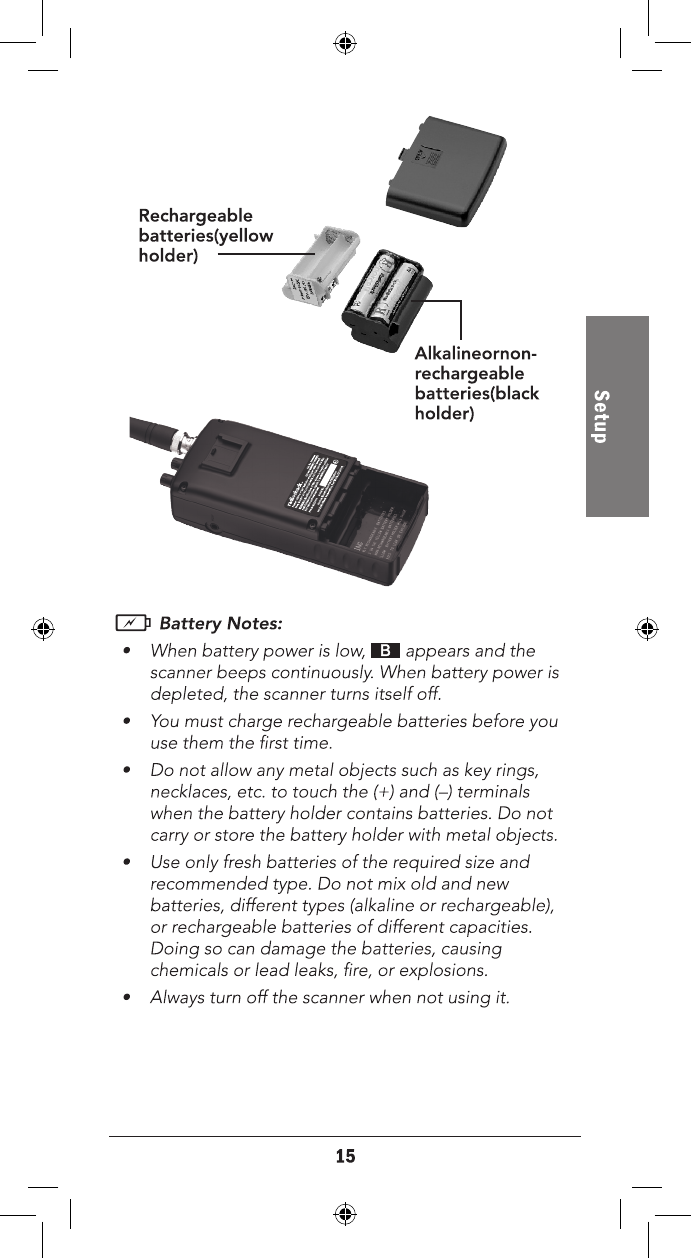
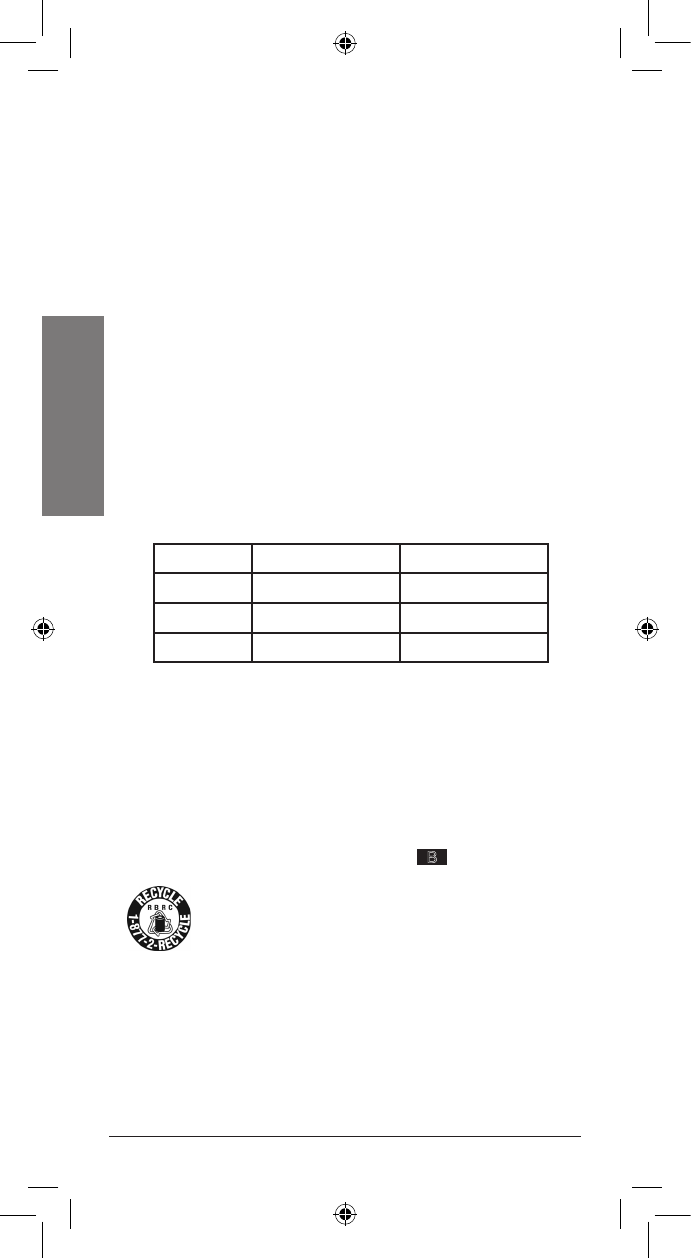
16
Setup
• Remove old or weak batteries. If you will not use
the scanner with batteries for a month, remove the
batteries. Batteries can leak chemicals that destroy
electronic circuits.
• In the event that a battery leaks, shows
transformation, discoloration, or abnormal
generation of heat, stop operation and replace the
batteries.
• Always dispose of old batteries promptly and
properly. Do not bury or burn them.
Charging Rechargeable Batteries
1. Install rechargeable batteries using the yellow
battery holder.
2. Connect an external power source to the PWR DC
9V jack using a 9V 400mA AC/DC adapter (not
supplied). The average charging times are listed
below.
Battery Current Charge Time
Ni-MH 1600 mAh 16 hours
Ni-Cd 600 mAh 6 hours
Ni-Cd 850 mAh 8 hours
b Recharging Notes:
• Do not overcharge batteries. Overcharging
shortens battery life.
• Using the scanner while charging will increase
charge time.
• Rechargeable batteries last longer and deliver more
power if you let them fully discharge once a month.
To do this, use the scanner until B appears.
Recycle Rechargeable Batteries
Placing rechargeable batteries in the trash can
be harmful to the environment. Instead, recycle
old rechargeable batteries at your local RadioShack
store free of charge. RadioShack participates in the
RBRC© battery recycling program, and is committed
to preserving the environment and conserving natural
resources. Call 1-800-THE-SHACK (1-800-843-7422) for
more information.
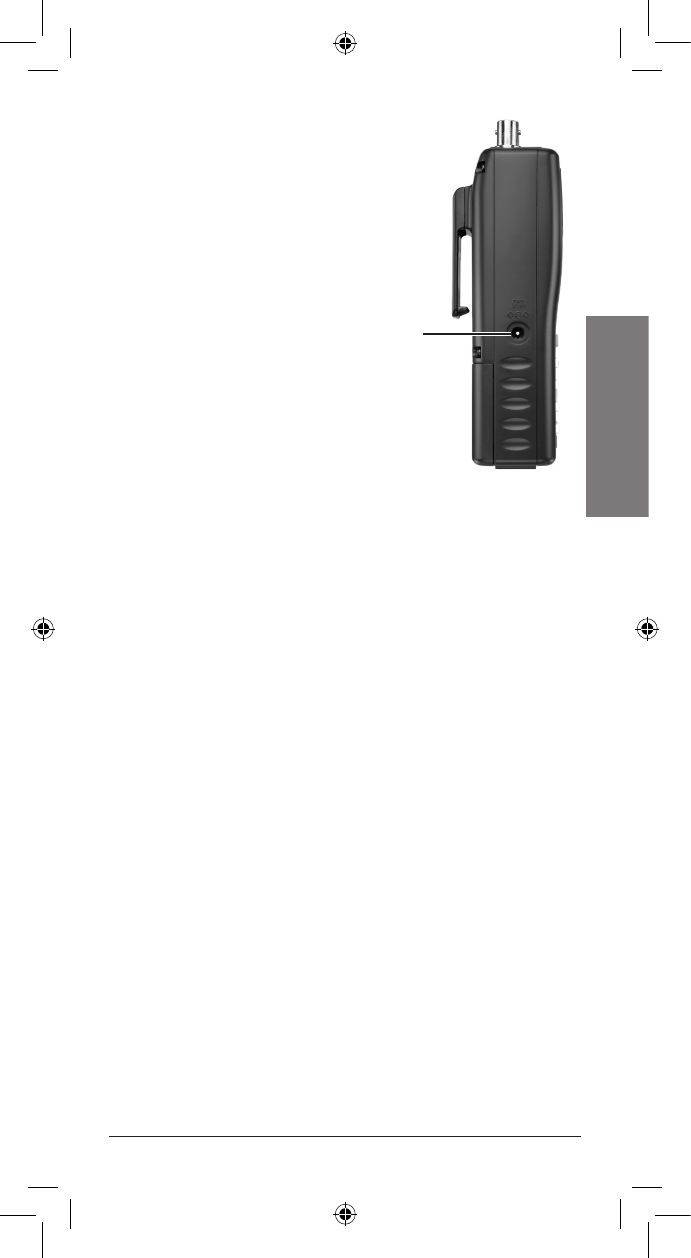
17
Setup
Using External Power
You can power your scanner using a
power source that supplies 9V DC and
delivers at least 400mA. Its center tip
must be set to positive and its plug
must fit the scanner’s PWR DC 9V jack.
To use an external power source:
1. Connect the adapter (not supplied)
to the scanner’s PWR DC 9V jack.
2. Plug the adapter into the power
source (standard AC power or your
vehicle’s power port).
3. To disconnect, unplug the adapter
from the power source first.
If you use an external power source for regular
operation, install alkaline batteries for emergencies.
Rechargeable batteries will self-discharge, even when
not used, and could have no usable power.
n Notes:
• Connecting an AC or DC adapter to the scanner
disconnects internal batteries when you use the
black non-rechargeable battery holder, but it does
not disconnect internal batteries when you use the
yellow rechargeable battery holder.
• If the scanner stops working properly after
connecting it to power, try resetting it (see
“Initializing the Scanner” on page 33).
• If you are powering from your vehicle’s power port
and your vehicle’s engine is running, you might hear
electrical noise from the engine while scanning.
This is normal.
w Caution: You must use a Class 2 power source
that supplies 9V DC and delivers at least 400mA. Its
center tip must be set to positive and its plug must fit
the scanner’s PWR DC 9V jack. Using an adapter that
does not meet these specifications could damage the
scanner or the adapter.
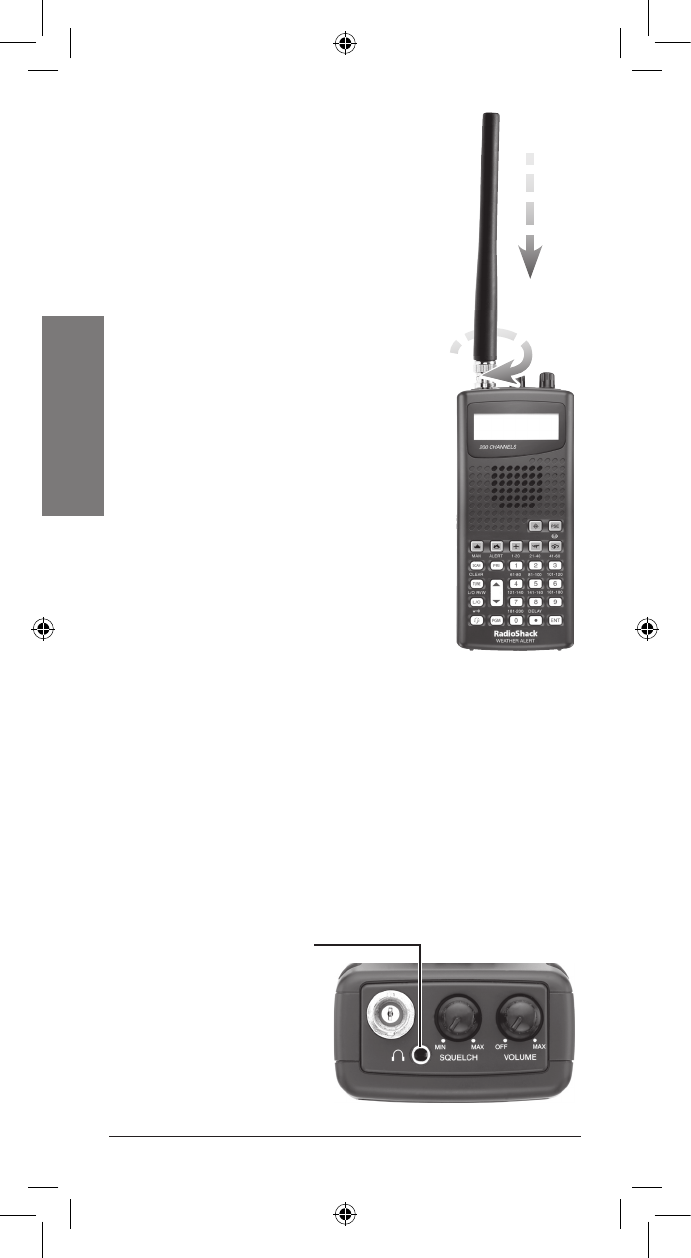
18
Setup
Connecting the Antenna
To attach the supplied flexible
antenna:
1. Align the slots around the
antenna’s connector with the tabs
on the antenna jack.
2. Press the antenna down over the
jack.
3. Turn the antenna’s base clockwise
until it locks into place.
Connecting an Outdoor Antenna
To connect an external antenna,
follow the installation instructions
supplied with the antenna. Use 50-
ohm coaxial cable to connect your
scanner to the outdoor antenna.
For lengths between 50 and 100
feet, use RG-8X low-loss dielectric
coaxial cable. For lengths over 100
feet, use RG8. You also may need a
BNC adapter (available at your local
RadioShack store).
w Warning: Use extreme caution when installing or
removing an outdoor antenna. If the antenna starts to
fall, let it go! It could contact overhead power lines. If
the antenna touches a power line, touching the antenna,
mast, cable, or guy wires can cause electrocution and
death. Call the power company to remove the antenna.
DO NOT attempt to do so yourself.
Connecting Headphones
For private listening, you can plug an Çinch (3.5-mm)
mini-plug earphone or headphones (not supplied), into
the HEADPHONE jack
on the top of
the scanner. This
automatically
disconnects the internal
speaker.
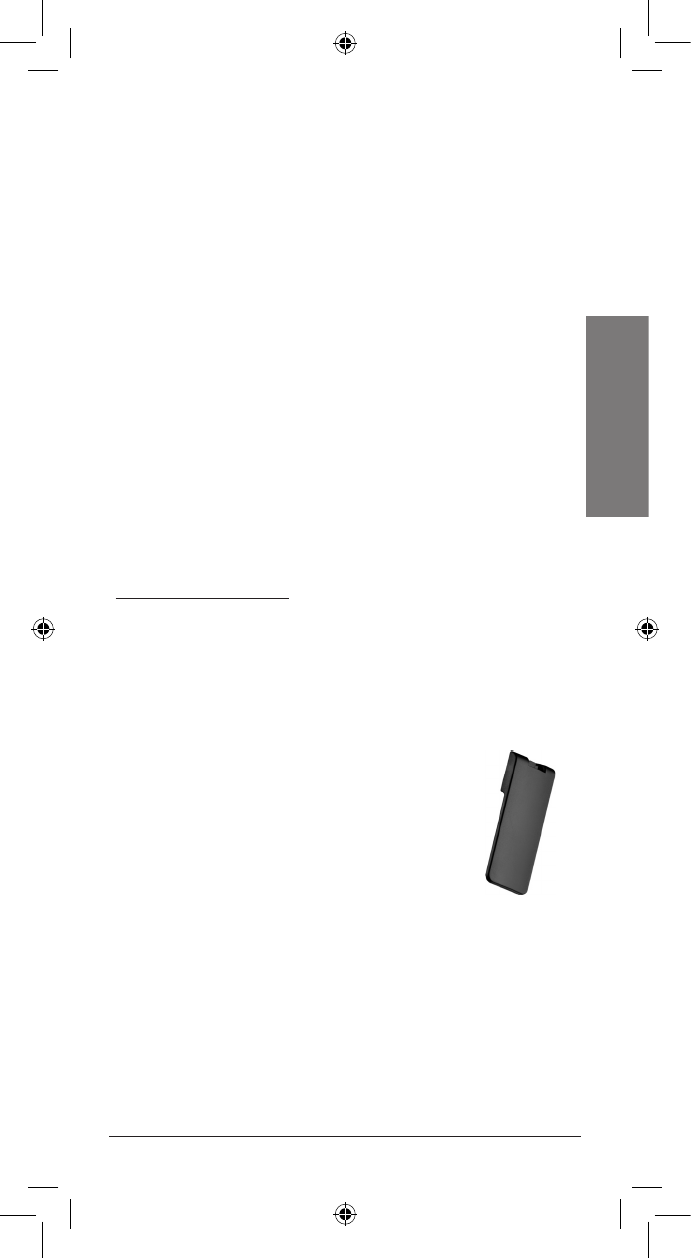
19
Setup
Listening Safely
Do not wear headphones, earphones, or earbuds while
operating a motor vehicle or riding a bicycle. This can
create a traffic hazard and could be illegal in some
areas.
To protect your hearing, follow these guidelines:
• Do not listen at high volume levels. Extended high-
volume listening can lead to permanent hearing
loss.
• Set the volume to the lowest setting. Then turn
on your audio device and adjust the volume to a
comfortable level.
• Avoid increasing the volume. Your ears will adapt
to the volume level, so a level that does not cause
discomfort could still damage your hearing.
Connecting an Extension Speaker
In a noisy area, an amplified extension speaker
(available from your local RadioShack store or
www.RadioShack.com), might provide more comfortable
listening. Plug the speaker cable’s Ç inch (3.5 mm)
miniplug into your scanner’s HEADPHONE jack.
n Note: Use an amplified speaker with this scanner.
Non-amplified speakers do not provide sufficient
volume for comfortable listening.
Attaching/Removing the Belt Clip
You can attach the belt clip to the back
of the scanner for hands-free carrying.
Slide the supplied belt clip down on the
back of the scanner. To remove the belt
clip, pull the tab out and slide the clip
upward.
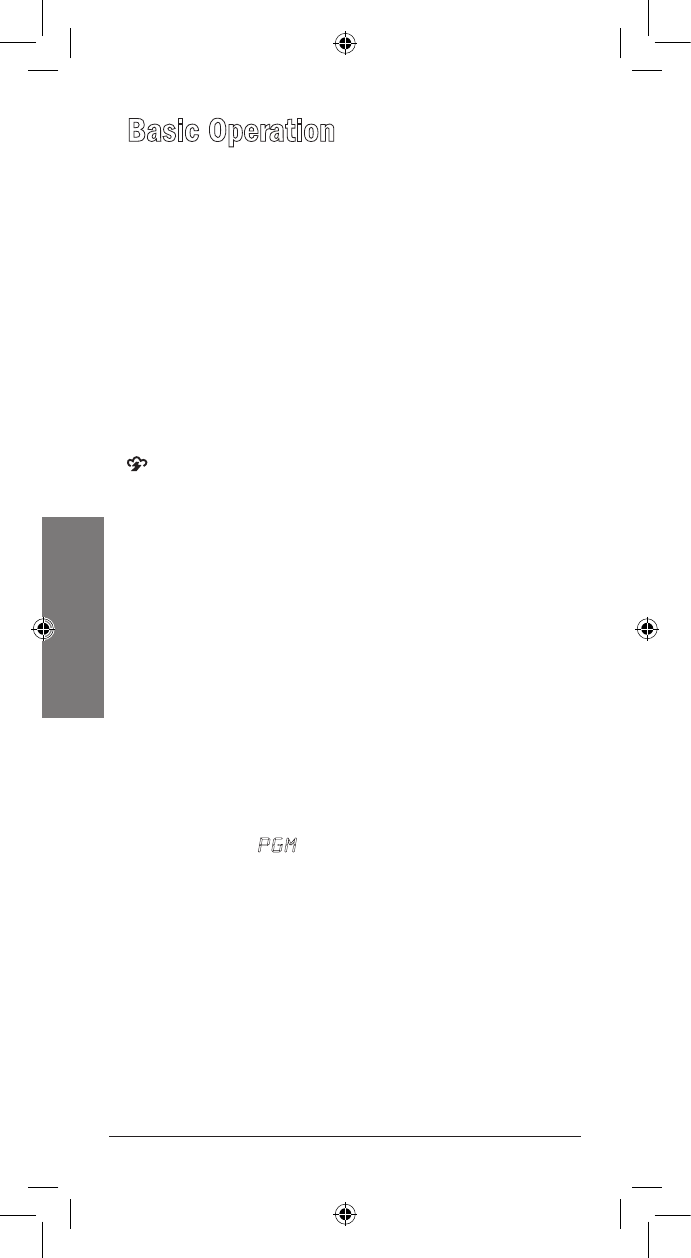
20
Basic Operation
Basic Operation
Turning on the Scanner and Setting
Squelch
1. Turn SQUELCH counterclockwise until the indicator
points to MIN.
2. Turn VOLUME clockwise to turn on the scanner. A
welcome message appears. After about 3 seconds,
you might hear a hissing sound. Then adjust
VOLUME to a comfortable listening level.
3. Turn SQUELCH clockwise, just until the hissing
sound stops.
To perform a quick check of scanner operation, press
. If you are near a NOAA weather station, you should
hear weather information.
n Notes:
• Make sure the scanner’s antenna is connected
before you turn it on.
• To listen to a weak or distant station, turn
SQUELCH counterclockwise.
• If reception is poor, turn SQUELCH clockwise to cut
out weak transmissions.
• If SQUELCH is adjusted so you always hear a
hissing sound, the scanner will not scan or search
properly.
Programming Known Frequencies into
Channels
1. Press PGM.
PGM
appears. Enter the channel
number (1–200) where you want to store a
frequency, then press PGM again.
2. Use the number keys and • to enter the frequency
(including the decimal point).
3. Press ENT to store the frequency into the channel.
4. To program the next channel in sequence, press
PGM and repeat Steps 2 and 3.
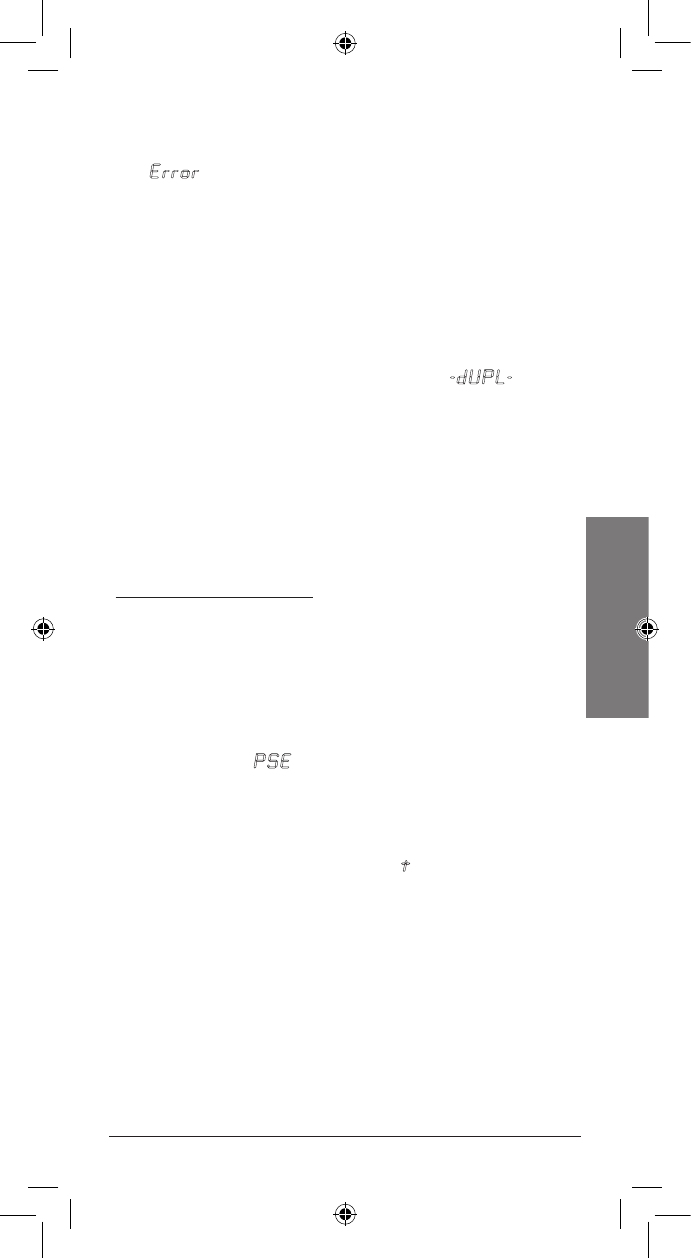
21
Basic Operation
n Notes:
• If you made a mistake entering the frequency,
Error
appears and the scanner beeps three times
when you press ENT. Start again from Step 2.
• Your scanner automatically rounds the entered
frequency down to the closest valid frequency. For
example, if you enter a frequency of 151.473, your
scanner accepts it as 151.470.
• If you entered a frequency that is already stored
in another channel, the scanner beeps three times
and displays the lowest channel number where
the frequency is already stored, while
-dUPL-
(duplicate) and the frequency flashes. Press ENT if
you still want to store the frequency. Press TUNE/
CLEAR to cancel.
• Press •/DELAY to set a two-second delay on this
channel. The scanner stores this setting in the channel.
If you do not have a list of frequencies in your area,
use a Tune search or a Service Bank search to find
transmissions. Or refer to an online resource such as
www.radioreference.com.
Searching for Active Frequencies
Tune Search
During a tune search, the scanner tunes up or down
starting from a frequency you specify.
1. Press TUNE.
PSE
and the starting frequency
appear.
2. If you want to change the starting frequency, enter
a new frequency and press ENT.
3. Press PSE to start tune search. -
t
- appears on the
display.
4. To change the tuning direction, press e or d.
n Notes:
• Press •/Delay to turn the two-second delay feature
on and off.
• Press L/O to lock-out a frequency.
• Press PSE to pause searching. Press PSE again to
resume.

22
Basic Operation
Service Bank Search
Your scanner contains groups of preset frequencies
called Service Banks. You can search for marine, fire/
police, aircraft, ham, and weather transmissions even if
you do not know the specific frequencies that are used
in your area. Then you can store the frequencies you
find into the scanner’s channels (except for weather and
marine banks, which are already stored as channels).
1. Press , , , , or .
MAr, FIrE POLICE
,
AIr
,
HAM,
or
WEAtHEr
appears respectively. After about two seconds, the
service search starts.
2. To search for another active frequency in the
selected bank, press e or d.
See “Preprogrammed Service Bank Frequencies” on page 6
for a list of the frequencies.
n Notes:
• Press •/Delay to turn the two-second delay feature
on and off.
• Press L/O to lock-out a frequency.
• Press PSE to pause searching. Press PSE again to
resume.
• To reverse the search direction at any time, press
e or d.
• If necessary, you can select search groups using the
number keys.
• The frequencies in the scanner’s Service Banks are
preset. You cannot change them.
Signal Stalker II Search
Signal Stalker II is a powerful tool to rapidly detect,
monitor, store, or lock-out frequencies from nearby
radio transmissions.
You can search for activity on all banks, Police/Fire,
Aircraft, or Ham Service Banks.
• When the scanner is in manual, scan, or tune mode,
press to search for activity on all banks.
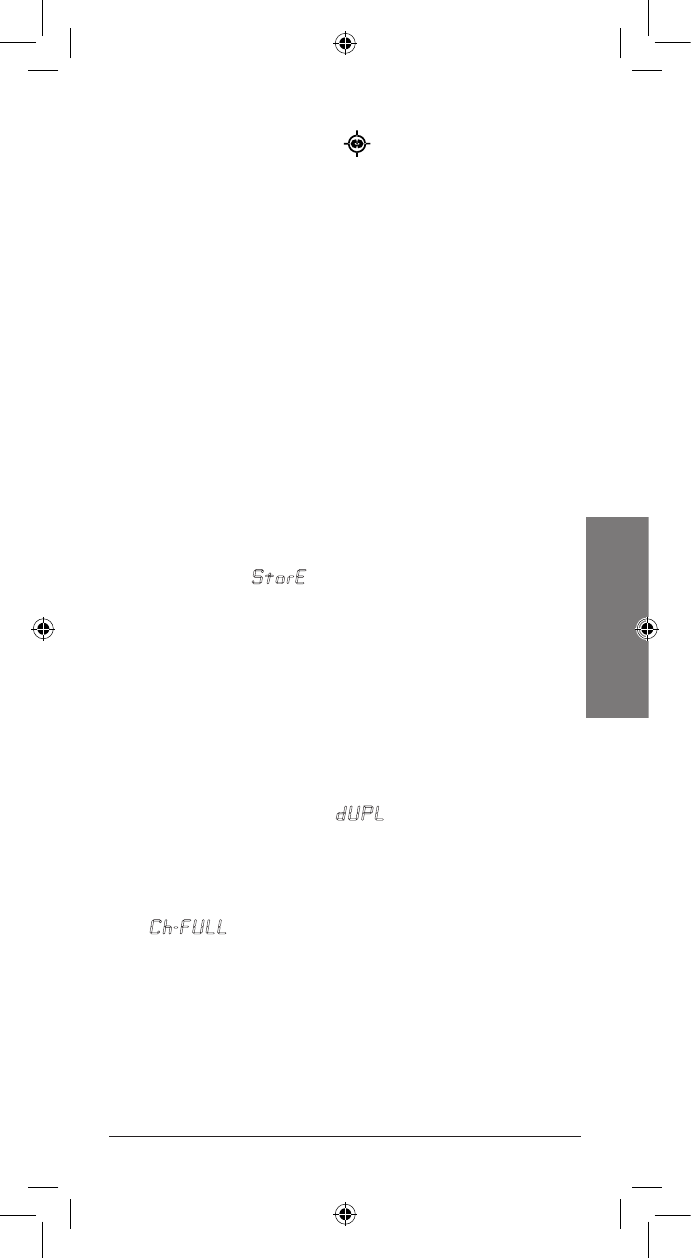
23
Basic Operation
• When the scanner is in the Police/Fire, Aircraft, or
Ham Service Bank, press to search for activity on
the corresponding bank.
• Activate and deactivate frequency sub-banks by
pressing the corresponding number key while Signal
Stalker II is searching.
Once an active frequency is found, the transmission is
played and you can store it in the scanner’s channel-
storage banks.
n Note: Priority mode is not available while using
Signal Stalker II.
Storing Found Frequencies into
Channels
Once you find interesting frequencies during a Tune,
Service Bank, or Signal Stalker II search, you can store
them in the scanner’s channel-storage banks.
1. Press ENT when you find a frequency. The bank
number and
StorE
appear.
2. If you want to change banks, enter the new bank
number.
3. Press ENT to store the frequency. The channel and
frequency flash twice. To cancel the operation,
press TUNE/CLEAR.
n Notes:
• The frequency is automatically stored in the first
empty channel of the selected bank.
• If the scanner displays -
dUPL
-, the frequency is
already stored in another channel. Press ENT if
you want to continue storing the frequency. Press
TUNE/CLEAR to cancel.
• If there are no empty channels in the bank,
Ch-FULL
appears. You can select another bank
or clear some channels in the current bank (see
“Clearing a Stored Channel” on page 25).
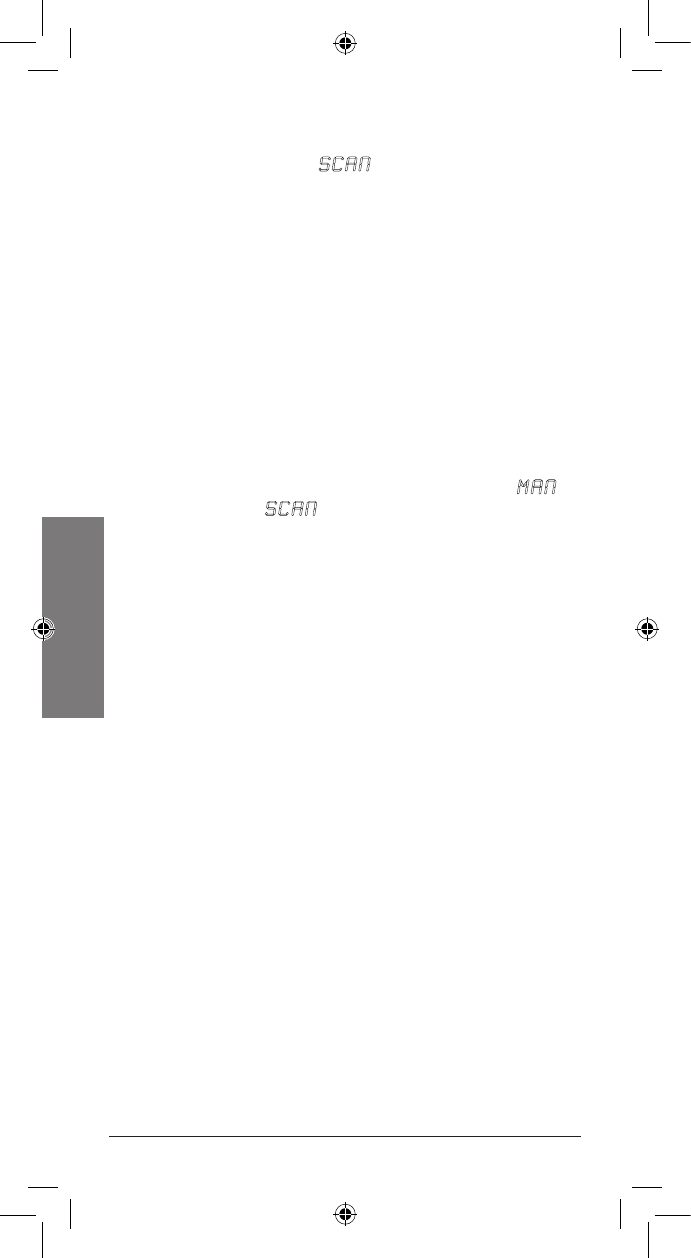
24
Basic Operation
Scanning the Stored Channels
Press SCAN/MAN until
SCAN
appears to continuously
scan through all channels with stored frequencies.
If the scanner finds an active frequency, it stops and
displays that channel and frequency number, then
it automatically begins scanning again when the
transmission on that frequency ends.
n Notes:
• Press e or d to reverse the scanning direction.
• Press •/DELAY to set the scanner to remain on
the current channel for two seconds after the
transmission ends.
• To set the scanner to remain on the current channel,
even after the transmission stops, press SCAN/
MAN at any time during the transmission so
MAN
appears and
SCAN
disappears (see “Monitoring a
Stored Channel” below).
• Press L/O to lock-out a channel.
Turning Channel-Storage Banks On and Off
To turn a channel-storage bank on or off, press the
bank’s number key (1–0, using 0 for bank 10) during
scanning. The channel-storage banks are on when
they have a bar underneath them and off when no bar
appears underneath them.
n Notes:
• The scanner does not scan any of the channels
within the banks you have turned off.
• You cannot turn off all banks; there must be at least
one active bank.
• You can manually select any channel in a bank, even
if the bank is turned off.
• When you turn on a bank during scanning, the
scanner moves to the selected bank and scans it.
• If no transmission is found, the scanner continues to
scan through all selected banks.
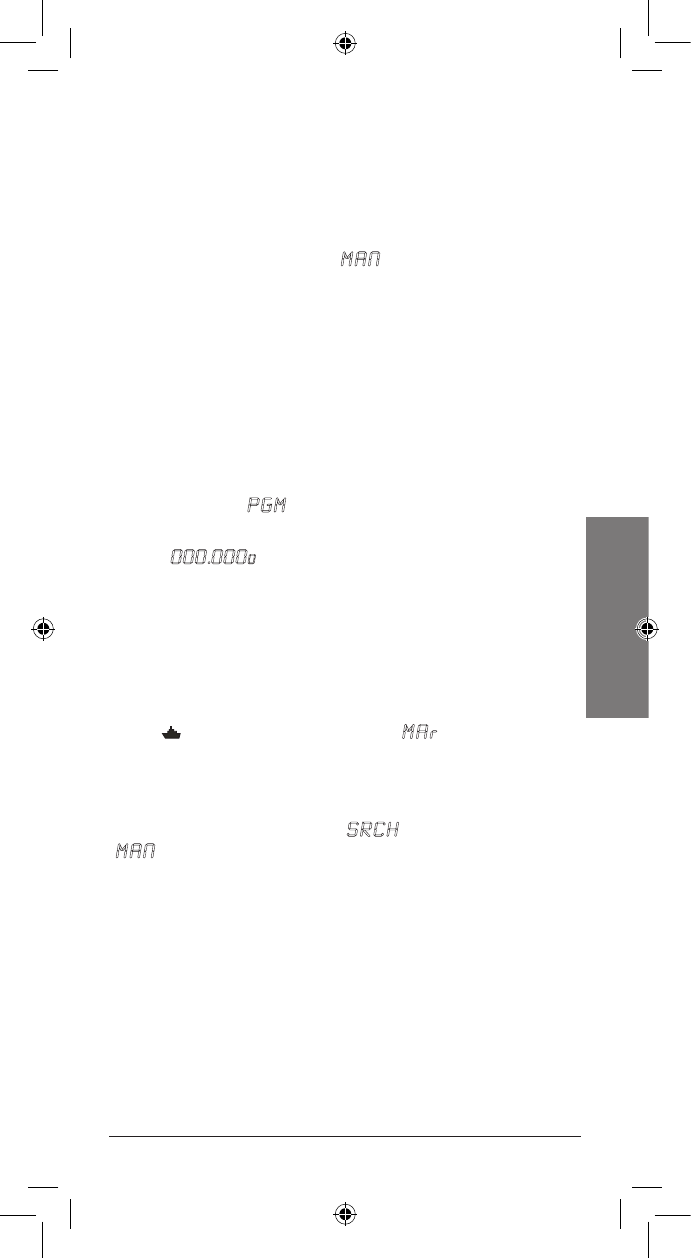
25
Basic Operation
Monitoring a Stored Channel
You can continuously monitor a specific channel without
scanning. This could be useful if you hear a transmission
on a channel and do not want to miss any details, even
though there might be periods of silence.
1. Press SCAN/MAN until
MAN
appears.
2. Enter the channel number (1–200).
3. Press SCAN/MAN again.
Clearing a Stored Channel
To remove a frequency stored in a channel.
1. Press SCAN/MAN to stop scanning.
2. Press the number keys to enter the channel number
(1–200).
3. Press PGM.
PGM
appears.
4. Press 0 then ENT. The frequency number changes
to
000.0000
to indicate the channel is cleared.
5. To clear another channel, use the number keys to
enter that channel number then press PGM again.
Or, repeatedly press PGM until the desired channel
number appears. Repeat Step 4.
Listening to the Marine Bank
Press to search the marine bank.
MAr
appears about
two seconds, then the scanner starts searching from
marine channel 16. To change the search direction,
press e or d.
Press PSE to stop searching.
SRCH
disappears and
MAN
appears.
• To change the channel manually, press e or d.
• To select a channel directly, enter the two-digit
channel number. See “Marine Service Bank” on page 6
for a list of channels.
• To lock-out a frequency, press L/O.
Press PSE again to restart the marine bank search.
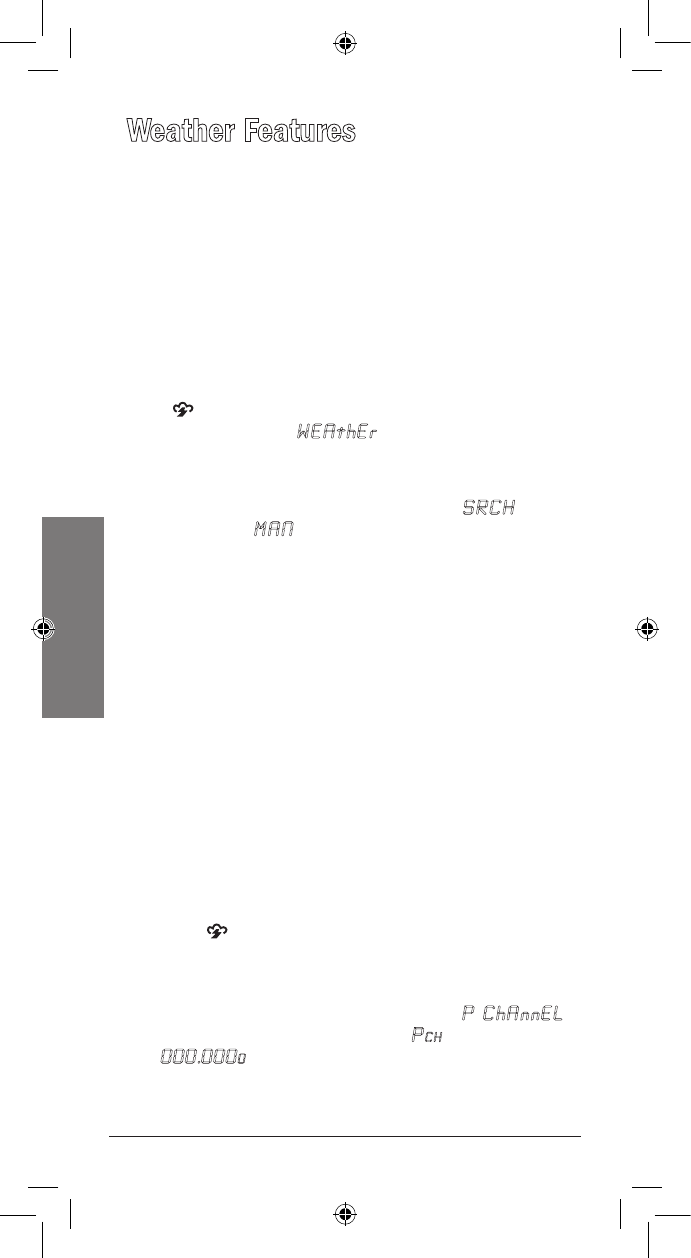
26
Basic Operation
Weather Features
The FCC (Federal Communications Commission) has
allocated channels for use by the National Oceanic
and Atmospheric Administration (NOAA). Regulatory
agencies in other countries have also allocated channels
for use by their weather reporting agencies.
The NOAA and your local weather reporting agency
broadcast the local forecast and regional weather
information on one or more of these channels.
Listening to a Weather Channel
Press to hear your local forecast and regional
weather information.
WEAthEr
appears for about two
seconds, then the scanner starts searching the weather
bank.
Press PSE to stop searching the channels.
SRCH
disappears and
MAN
appears. To change the channel
manually, press e or d.
n Note: Your scanner incorporates weather alert as
one of its features and is an extremely sensitive high
quality receiver on the weather frequencies. However,
the included flex antenna is optimized for general
purpose scanning. If you use this scanner as your only
means for receiving weather alerts, please make sure
you are receiving a clear signal on the flex antenna
or switch to an external antenna that gives you clear
reception of a local NOAA weather broadcast.
Weather Alerts
Receiving All Weather Alerts
To program the scanner to search for weather alerts every
two seconds, set a weather channel as the priority channel.
1. Press .
2. Select the weather channel you want to set as the
priority channel.
3. Press and hold ENT then PRI/ALERT.
P ChAnnEL
is displayed momentarily. Then
PCH
flashes and
000.0000
(or the previously-stored frequency)
appears.
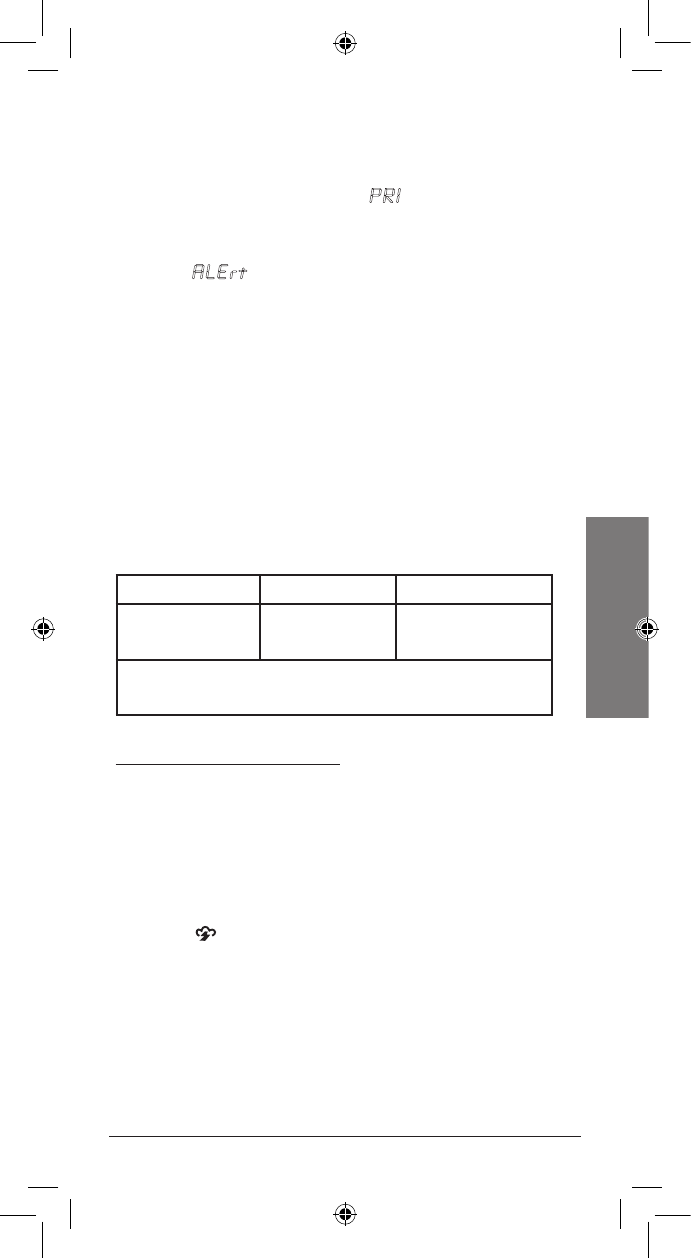
27
Basic Operation
4. Press ENT to store the priority channel. The display
flashes twice. Press TUNE/CLEAR to cancel.
5. Press PRI/ALERT during scanning or searching to
turn on the priority feature.
PRI
appears.
If the scanner detects a 1050 Hz weather alert tone on
the programmed channel, the scanner sounds the alert
tone and
ALErt
flashes. Press any key to turn off the
alarm.
Receiving Alerts for Specific Areas
About SAME Signals
The National Weather Service precedes each weather
alert with a digitally encoded SAME (Specific Area
Message Encoding) signal, then a 1050 Hz tone. The
SAME signal includes a FIPS (Federal Information
Processing Standard) code and an event code that
corresponds with the type of alert being sent.
The FIPS code format is:
Subdivisions State County
0-9
(0=entire area)
01-50
(00=all states)
XXX
(000=all counties)
Example: 048439
(0=All; 48=Texas; 439=Tarrant County)
A current list of FIPS codes is located at
www.NWS.NOAA.gov/NWR.
SAME Standby Mode
In SAME Standby mode, your scanner monitors weather
channels for SAME alerts for up to seven areas you
specify by entering the FIPS codes.
To program your scanner for SAME Standby mode:
1. Press .
2. Press PGM to access the FIPS code entry mode.
3. Use e or d to select the desired FIPS code storage
location.
4. Use the number keys to enter the FIPS code, then
press ENT to store the code.
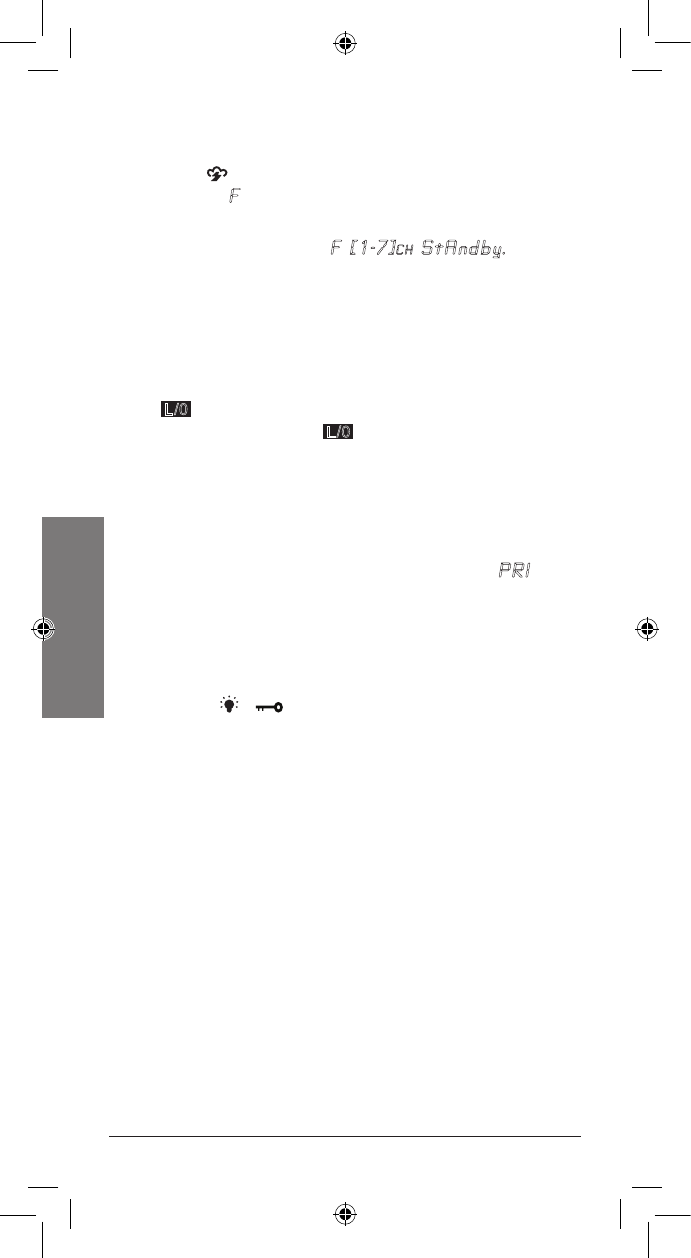
28
Basic Operation
5. Repeat steps 3-4 for all the FIPS codes that you
wish to store.
6. Press to exit FIPS code entry mode. The scanner
displays
F
showing that FIPS codes are enabled.
7. Press PRI/ALERT to initiate SAME Standby mode.
The scanner displays
F [1-7]CH StAndby.
The scanner will monitor weather channels for alerts
with matching FIPS codes. To exit SAME Standby mode,
press PRI/ALERT again.
n Notes:
• Press L/O during step 4 to lock-out FIPS entries;
L/0 appears in the display. Press L/O again to
enable FIPS entries; L/0 disappears.
• If you do not enter any FIPS codes, or if your FIPS
codes are locked out, when you enter SAME
Standby mode the scanner receives alerts and
warning messages for all receivable areas.
• When a weather channel is set as the priority
channel and priority operation is enabled (
PRI
shows in the display), all alerts are received and
FIPS settings are ignored.
• The scanner sounds an alert when it receives
the SAME code. To stop the alert and ready the
scanner to receive a new alert signal, press any key
except / .
• If you do not stop the alert within five minutes,
the alert stops and the scanner beeps every ten
seconds. If the scanner receives a new weather alert
after five minutes, it sounds the new alert.
Skywarn
Many areas of the country have amateur radio repeaters
that have been designated as “Skywarn” repeaters.
During times of severe weather, these repeaters are
used to relay reports of severe weather directly to
meteorologists at a local National Weather Service
forecast office. Using the Skywarn feature in your
scanner, you can easily jump to your local Skywarn
frequency and monitor these reports, in many cases
hearing about severe weather in your area instantly as it
occurs.
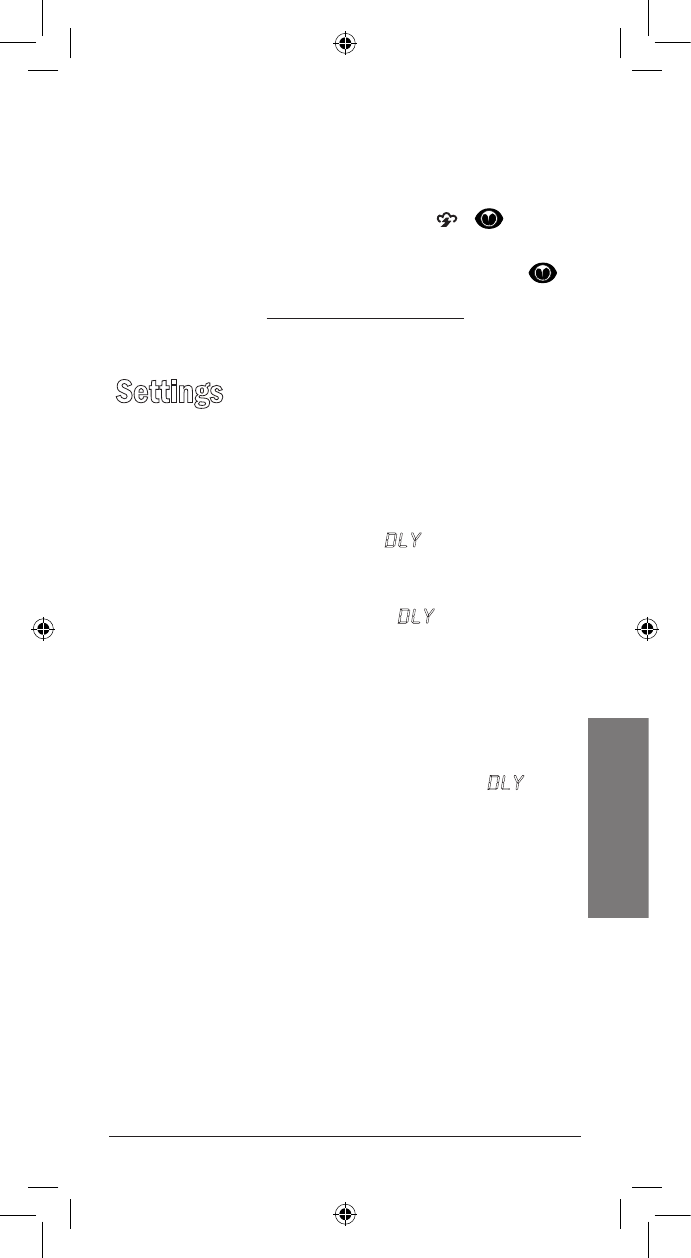
29
Settings
1. Before using this feature, you must program
the Skywarn frequency into channel 200 (see
“Programming Known Frequencies into Channels” on
page 20).
2. To activate Skywarn, press and hold / for
about two seconds.
3. The scanner jumps to channel 200 and displays .
n Note: Refer to www.radioreference.com to find the
skywarn frequencies in your area.
Settings
Setting Delay
To avoid missing a reply in conversations, a two-second
delay is automatically set for each channel. The scanner
stops for two seconds after a transmission ends before
it resumes scanning or searching.
DLY
appears in the
display when the delay function is active.
To turn delay off, press •/DELAY while the scanner is
monitoring a channel or frequency.
DLY
disappears.
To turn delay on:
• If the scanner is scanning and stops on an active
channel, quickly press •/DELAY before it resumes.
• If the desired channel is not selected, manually
select the channel, then press •/DELAY.
• If the scanner is searching, press •/DELAY.
DLY
appears and the scanner adds a two-second delay
to every transmission it stops on in that bank.
Locking Out Channels and Frequencies
You can increase the scanning or search speed by
locking out channels or frequencies that have a
continuous transmission, such as control channels,
weather channels, or birdie frequencies.
Press L/O when the scanner stops on a channel or
frequency while scanning or searching. The scanner
locks out the channel/frequency then continues
scanning/searching.
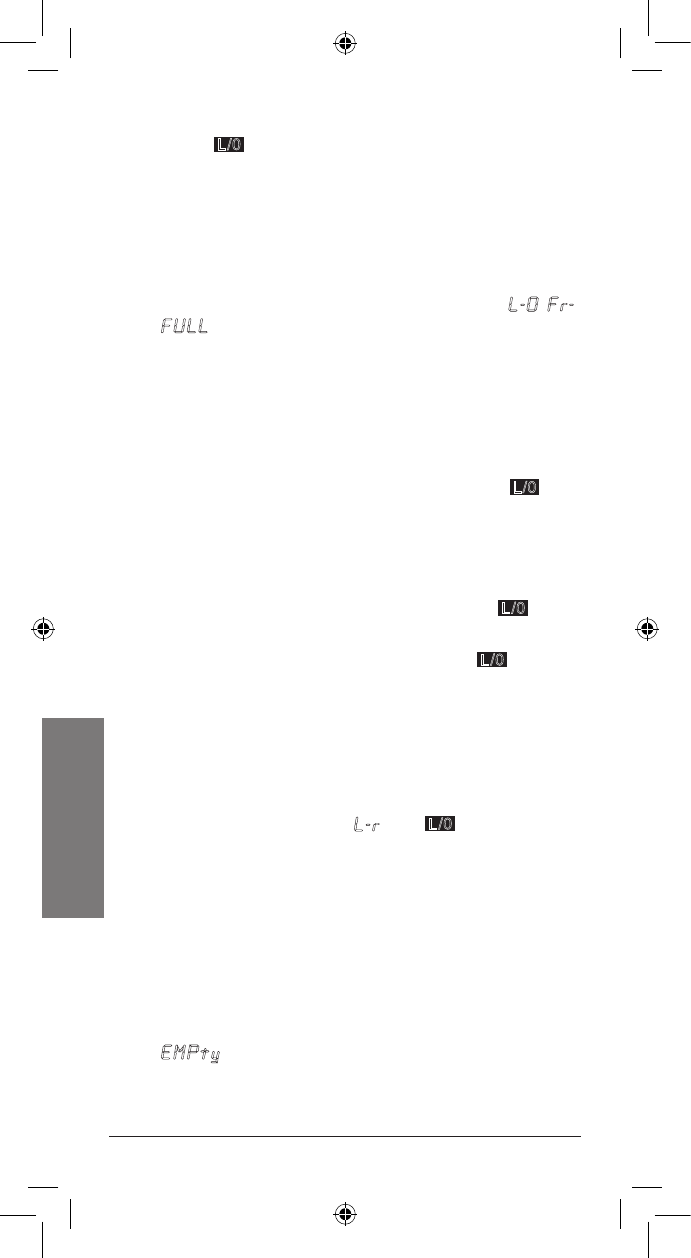
30
Settings
To manually lock-out a channel, select the channel then
press L/O. L/0 appears in the display.
n Notes:
• Your scanner automatically locks out empty
channels.
• You can still manually select locked-out channels.
• You can lock-out a maximum of 50 frequencies
during a search. If you try to lock-out more,
L-O Fr-
FULL
appears.
• The scanner uses same lock-out list between the
Service Banks and Signal Stalker II.
Reviewing and Removing Lock-outs
Stored Channels
Manually select the channel and press L/O until L/0
disappears.
Marine Service Bank
1. Press PSE during the Marine Service Bank search.
2. Press e or d to select channels manually. L/0
appears next to locked-out channels.
3. To remove the lock-out, press L/O until L/0
disappears.
Other Service Banks and Signal Stalker II
1. Hold down L/O
/
L/O RVW for about two seconds
during a Service Bank or Signal Stalker II search.
2. Press e or d repeatedly to scroll through the list of
locked-out frequencies.
L-r
and L/0 appear in the
display.
3. Press L/O to remove the lock-out. The list scrolls to
the next locked-out frequency.
n Notes:
• When you reach the highest locked-out frequency,
the scanner beeps twice and rolls to the lowest
locked-out frequency.
• If the Service Bank has no locked-out frequencies,
EMPty
appears.
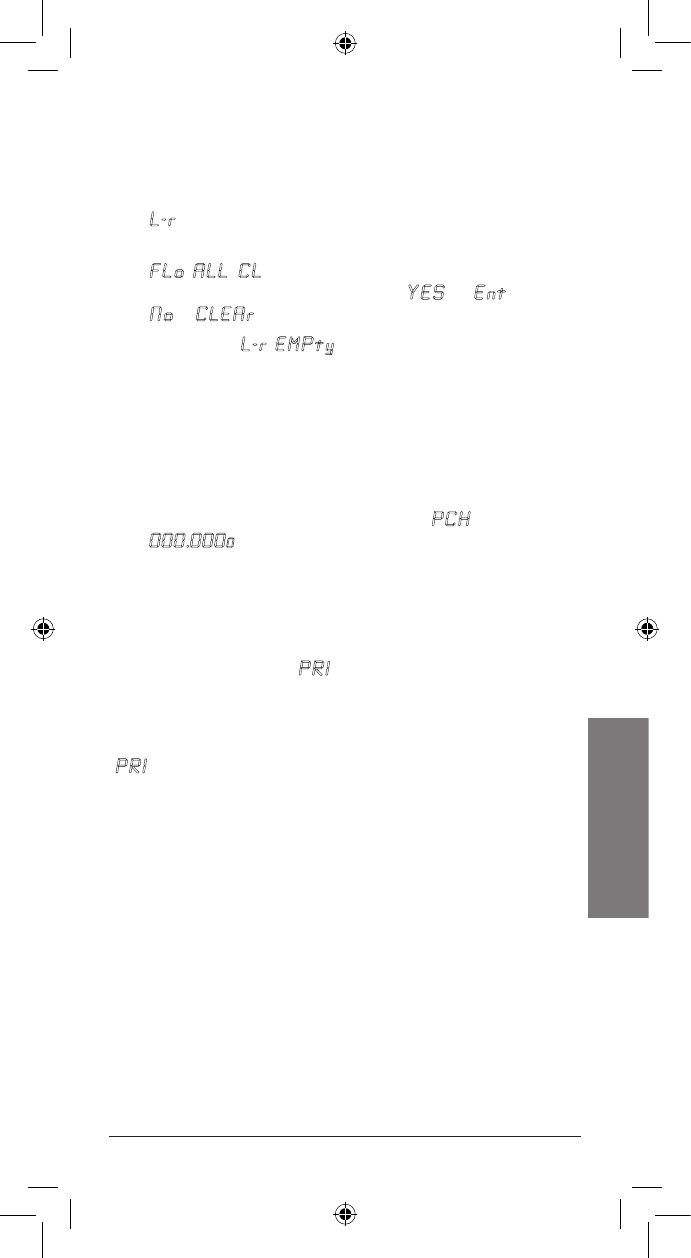
31
Settings
Removing Lock-outs from All Frequencies in a Service
Bank
1. Hold down L/O
/
L/O RVW for about two seconds
during a Service Bank or Signal Stalker II search.
L-r
appears.
2. While holding down TUNE/CLEAR, press L/O.
FLo ALL
–
CL
appears for about two seconds.
Then the display alternates with
YES
---
Ent
and
No
--
CLEAr
.
3. Press ENT.
L-r EMPty
appears. The scanner clears
lock-outs from all frequencies in the Service Bank.
Using Priority
The priority feature sets the scanner to check one
channel every two seconds while scanning. You can
program one frequency into the priority channel.
1. Press PGM, then press PRI/ALERT.
PCH
and
000.0000
or the previously stored frequency
appear.
2. Enter the frequency you want stored in the priority
channel, then press ENT. The display flashes twice.
To turn on the priority feature, press PRI/ALERT during
scanning or searching.
PRI
appears. The scanner
checks the priority channel every two seconds and stays
on the channel if there is activity.
To turn off the priority feature, press PRI/ALERT.
PRI
disappears.
To program a weather channel as the priority channel
(see “Receiving All Weather Alerts “on page 26).
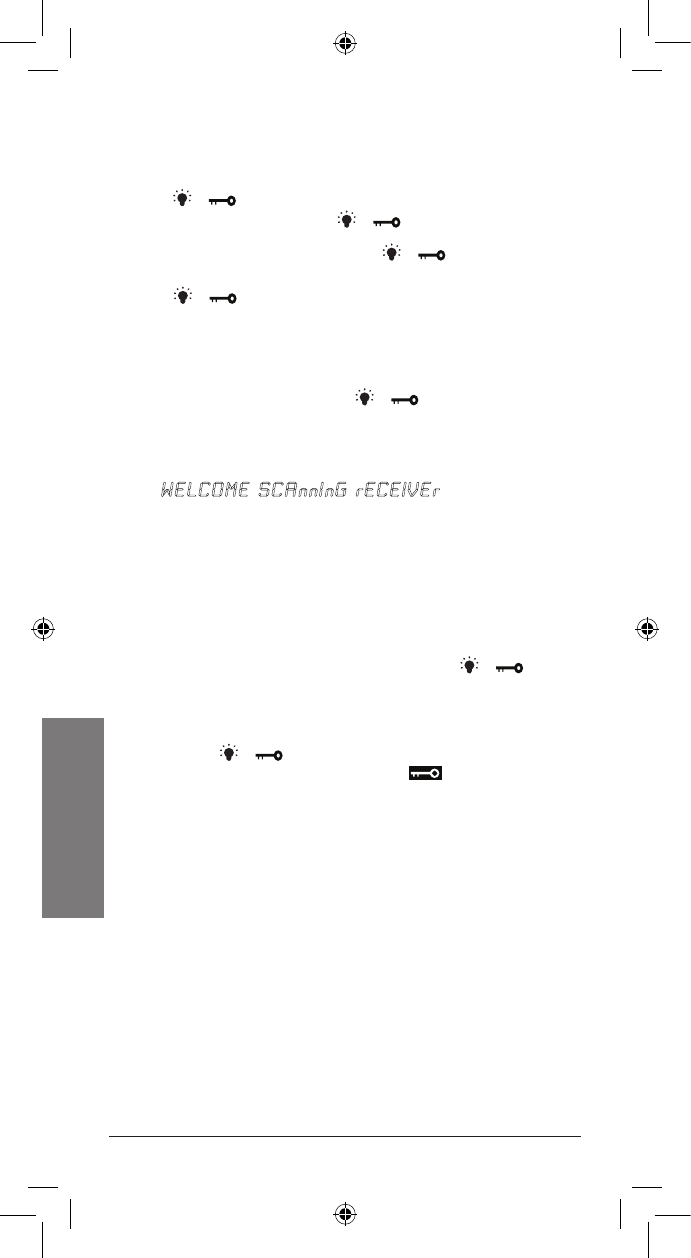
32
Settings
Using the Display Backlight
To turn the display backlight on and off:
Press / to turn on the backlight for five seconds.
To turn it off sooner, press / again.
Press and hold PGM then press / to turn on the
display’s backlight for an extended time. To turn it off,
press / again.
Turning the Key Tone On and Off
The scanner is preset to sound a tone each time you
press one of its keys (except / ).
To turn the key tone on and off:
1. If the scanner is on, turn it off then back on again.
2.
WELCOME SCAnnInG rECEIVEr
appears.
3. While the welcome message is on the screen, press
1 to turn on the key tone or press 2 to turn it off.
Using the Key Lock
Use the key lock feature to protect your scanner from
accidental program changes. When the keypad is
locked, the only controls that operate are / ,
VOLUME, and SQUELCH.
To turn on the key lock on and off:
Hold down / for about three seconds until
the scanner beeps three times and appears or
disappears.
n Note: The key lock does not prevent the scanner
from scanning channels or monitoring a single channel
(whichever feature you last selected).
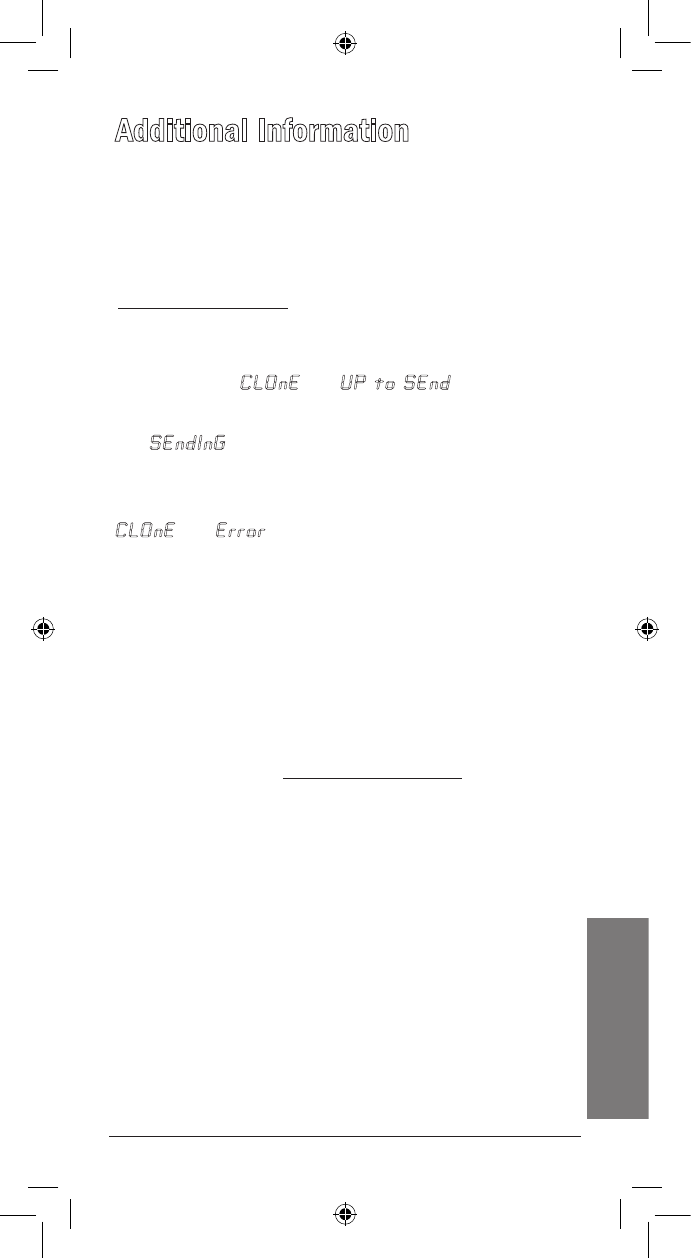
33
Additional Info
Additional Information
Cloning the Programmed Data
You can transfer the programmed data to and from a
PRO-649 scanner using an optional connecting cable
with Ç-inch (3.5mm) stereo phone plugs on both ends
(available from your local RadioShack store or
www.RadioShack.com).
1. Turn on both scanners.
2. Connect the connecting cable to each scanner’s
PC/IF jack.
CLOnE
and
UP to SEnd
appears.
3. Press e on the host scanner.
4.
SEndInG
appears at the host scanner.
The scanner sends the data. To exit the clone mode,
remove the cable.
CLOnE
and
Error
may alternately appear when the
scanner receives data from a scanner other than a
PRO-649. If this happens when the scanner is
receiving data from another PRO-649, turn off the
scanner and turn it on again.
Programming with a Personal
Computer
You can also upload or download programmed data to
or from a PC using a USB cable available from your local
RadioShack store or www.RadioShack.com.
The application software is available online. Use a
search engine to find “scanner programming software.”
Follow instructions in the software package to upload
and download data.
Initializing the Scanner
If the scanner’s display locks up or does not work
properly after you connect a power source, you might
need to initialize the scanner.
n Important: This procedure clears all information
you stored in the scanner’s memory. Only initialize the
scanner when you are sure the scanner is not working
properly.
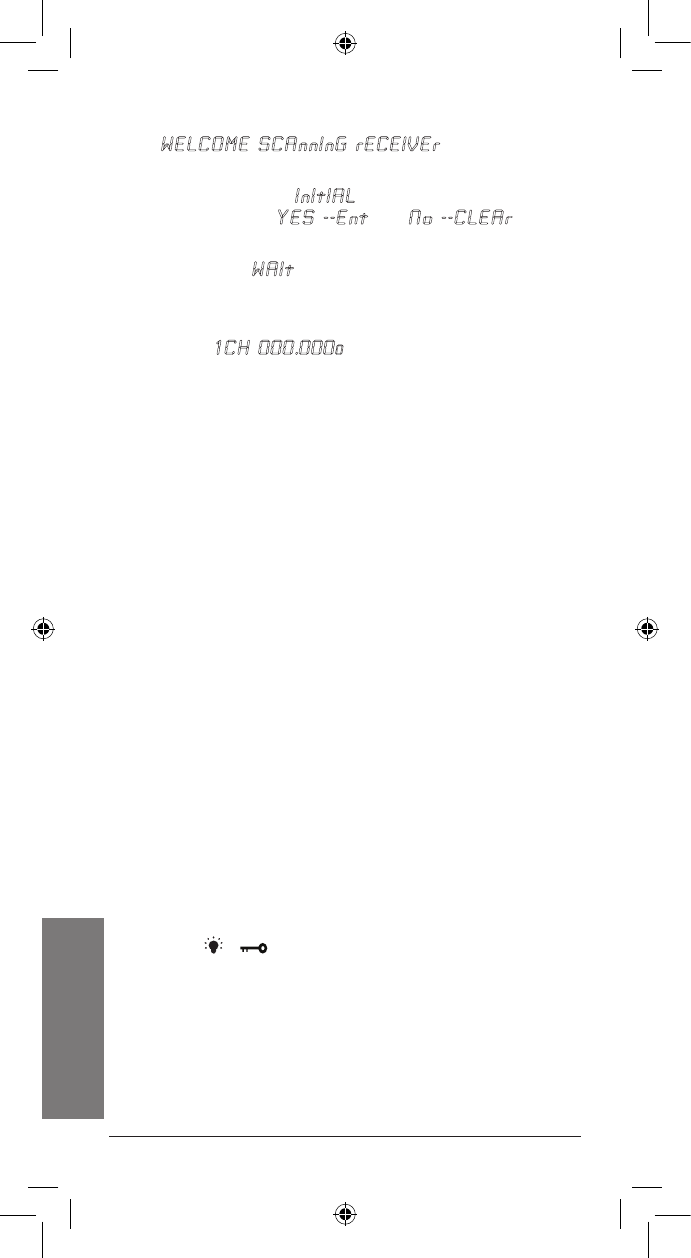
34
Additional Info
1. Turn off the scanner, then turn it on again.
WELCOME SCAnnInG rECEIVEr
appears.
2. Press 0, then press 1 while the welcome message
is on the screen.
InItIAL
appears for about two
seconds, then
YES --Ent
and
No --CLEAr
appear alternately.
3. Press ENT.
WAIt
appears for about two seconds.
n Note: Do not turn off the scanner until the
initialization is complete. When the initialization is
complete,
1CH 000.0000
appears on the display.
Troubleshooting
The scanner is not working at all.
• The AC or DC adapter might not be connected. Be
sure the adapter’s barrel plug is fully inserted into
the PWR DC 9V jack. The center tip of the adapter’s
barrel plug must be set to positive.
• The batteries might be dead or need to be
recharged. Recharge the rechargeable batteries or
replace the alkaline batteries.
The scanner does not receive any stations or
reception is poor.
• An antenna is not connected or is connected
incorrectly. Be sure an antenna is properly
connected to the scanner.
The scanner is on but does not scan.
• The squelch might not be adjusted correctly. Turn
SQUELCH clockwise.
• Only one channel or no channels are stored. Store
frequencies into more than one channel.
The keypad does not work.
• Keylock is turned on. Turn off keylock by holding
down / for about three seconds
• The scanner might need to be reset or initialized.
Turn the scanner off then on again, or initialize the
scanner (see “Initializing the Scanner” on page 33).
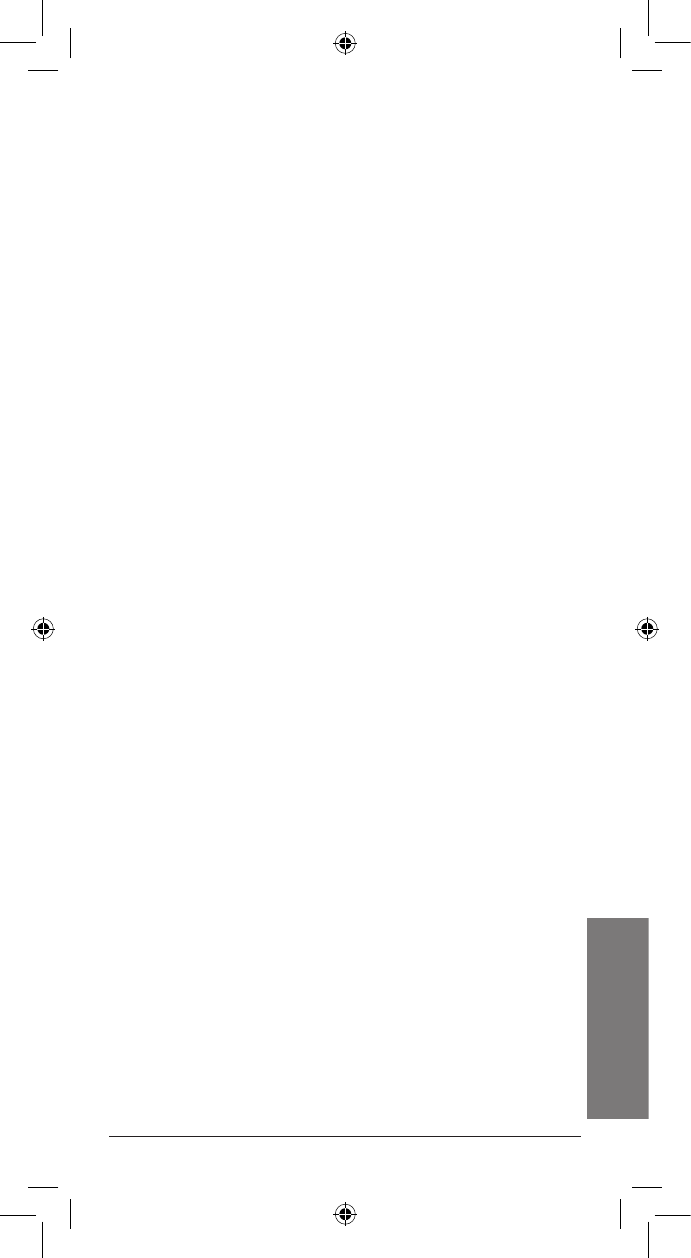
35
Additional Info
While scanning, the scanner locks on frequencies
that have an unclear transmission.
• Some frequencies programmed into the scanner
might be the same as birdie frequencies. Avoid
programming birdie frequencies or only listen to
them manually.
Birdie Frequencies
Every scanner has birdie frequencies. Birdies are signals
created inside the scanner’s receiver, which may interfere
with transmissions on the same frequencies. If you
program one of these frequencies, you hear only noise
on that frequency. If the interference is not severe, you
might be able to turn Squelch clockwise to omit the
birdie.
To find the birdies in your scanner, disconnect the
antenna and move it away from the scanner. Make sure
that no other nearby radio or TV sets are turned on near
the scanner. Use the Tune to search every frequency
range from its lowest frequency to the highest.
Occasionally, the searching will stop as if it has found a
signal, often without any sound. This is a birdie. Make a
list of all the birdies in your scanner for future reference.
FCC Notice
This equipment has been tested and found to comply
with the limits for a scanning receiver, pursuant to
Part 15 of the FCC Rules. These limits are designed
to provide reasonable protection against harmful
interference in a residential installation. This equipment
generates, uses and can radiate radio frequency energy
and, if not installed and used in accordance with the
instructions, may cause harmful interference to radio
communications.
However, there is no guarantee that interference will not
occur in a particular installation. If this equipment does
cause harmful interference to radio or television reception,
which can be determined by turning the equipment
off and on, the user is encouraged to try to correct the
interference by one or more of the following measures:
• Reorient or relocate the receiving antenna.
• Increase the separation between the equipment and
receiver.

36
Additional Info
• Connect the equipment into an outlet on a
circuit different from that to which the receiver is
connected.
This device complies with part 15 of the FCC Rules.
Operation is subject to the following two conditions:
(1) This device may not cause harmful interference, and
(2) this device must accept any interference received,
including interference that may cause undesired
operation.
Scanning Legally
Your scanner covers frequencies used by many
different groups including police and fire departments,
ambulance services, government agencies, private
companies, amateur radio services, military operations,
pager services, and wireline (telephone and telegraph)
service providers. It is legal to listen to almost every
transmission your scanner can receive. However, there
are some transmissions you should never intentionally
listen to. These include:
• Telephone conversations (cellular, cordless, or other
private means of telephone signal transmission)
• Pager transmissions
• Any scrambled or encrypted transmissions
According to the Electronic Communications Privacy
Act (ECPA), as amended, you are subject to fines and
possible imprisonment for intentionally listening to,
using, or divulging the contents of such a transmission
unless you have the consent of a party to the
communication (unless such activity is otherwise illegal).
This scanner is designed to prevent reception of illegal
transmissions, in compliance with the law which requires
that scanners be manufactured in such a way as to not
be easily modifiable to pick up those transmissions. Do
not open your scanner’s case to make any modifications
that could allow it to pick up transmissions that are not
legal to listen to. Doing so could subject you to legal
penalties.
In some areas, mobile use of this scanner is unlawful
or requires a permit. Check the laws in your area. We
encourage responsible, legal scanner use.
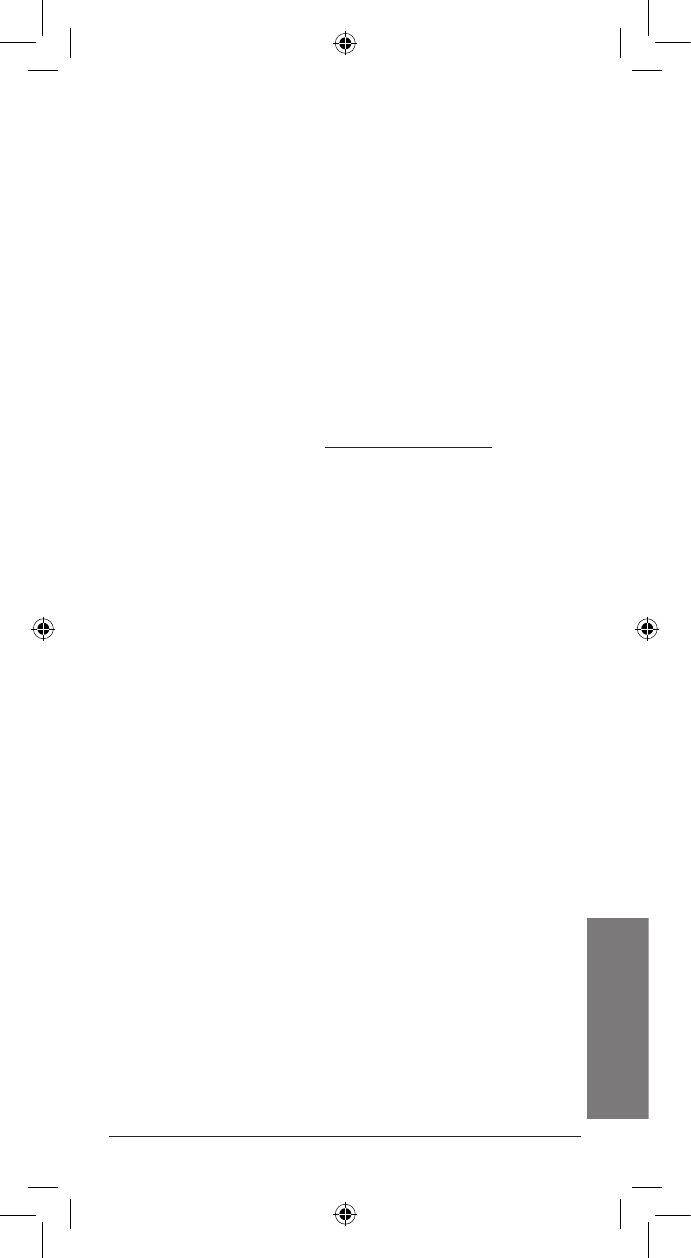
37
Additional Info
Care
Your scanner is not waterproof. Do not expose it to rain,
moisture, or extremely high humidity. If the scanner gets
wet, wipe it dry immediately. Use and store the scanner
only in normal temperature environments. Handle the
scanner carefully; do not drop it. Keep the scanner
away from dust and dirt, and wipe it with a damp cloth
occasionally to keep it looking new.
Service and Repair
If your scanner is not performing as it should, take it to
your local RadioShack store for assistance. To locate
your nearest RadioShack, use the store locator feature
on RadioShack’s website (www.radioshack.com), or call
1-800-The Shack (800-843-7422) and follow the menu
options. Modifying or tampering with the scanner’s internal
components can cause a malfunction and might invalidate
its warranty and void your FCC authorization to operate it.
Specifications
Frequency Coverage (MHz)
10 Meter Amateur Radio ................29–30 (in 5 kHz steps)
VHF Lo .............................................30–50 (in 5 kHz steps)
6 Meter Amateur Radio ..................50–54 (in 5 kHz steps)
Aircraft ...........................108–136.9875 (in 12.5 kHz steps)
Government ...........................137–144 (in 12.5 kHz steps)
2 Meter Amateur Radio ..............144–148 (in 5 kHz steps)
VHF Hi ..................................148–150.8 (in 12.5 kHz steps)
VHF Hi ....................................... 150.8-162 (in 5 kHz steps)
VHF Hi ..................................... 162-174 (in 12.5 kHz steps)
Amateur Radio/Government 380–450 (in 12.5 kHz steps)
UHF Standard.........................450–470 (in 12.5 kHz steps)
UHF “T” ..................................470–512 (in 12.5 kHz steps)
Channels of Operation .................................200 channels
Sensitivity (S+N)/N 20 dB
29–54 MHz .................................................................0.5 uV
108–136.9875 MHz ....................................................1.0 uV
137–174 MHz .............................................................0.5 uV
380–512 MHz .............................................................0.7 uV
Spurious Rejection (FM @154 MHz) ........................ 50 dB

38
Additional Info
Selectivity
±8 kHz ........................................................................ –6 dB
±17 kHz .................................................................... –50 dB
Search Speed ..................................... Up to 80 Steps/Sec
Scan Speed .................................. Up to 40 Channels/Sec
Delay Time ........................................................ 2 Seconds
IF Frequencies
1st IF .................................................................... 10.7 MHz
2nd IF ......................................................................455 kHz
IF Interference Ratio (10.7 MHz) .......... 70 dB at 154 MHz
Squelch Sensitivity
Threshold..................................................Less than 0.5 uV
Tight (FM) ................................................. (S + N)/N 25 dB
Tight (AM) ................................................ (S + N)/N 20 dB
Antenna Impedance ............................................50 Ohms
Audio Output Power (10% THD) ..........180 mW Nominal
Built-In Speaker.................1 3/8 Inches (36 mm), 8 Ohms
Operating Temperature ........14° to 140°F (–10° to 60°C)
Power Requirements ..................................4 AA Batteries
............................................9V AC Adapter (not supplied)
............................................9V DC Adapter (not supplied)
Current Drain (Squelched) ...................................... 45 mA
Dimensions (HWD) .............................5 Ð x 2 È x 1 Ï In
...............................................................(145 x 63 x 40 mm)
Weight (without antenna) ...............approx. 7.8 oz (220 g)
Specifications and depictions are subject to change and
improvement without notice. Actual product may vary
from the images found in this document.
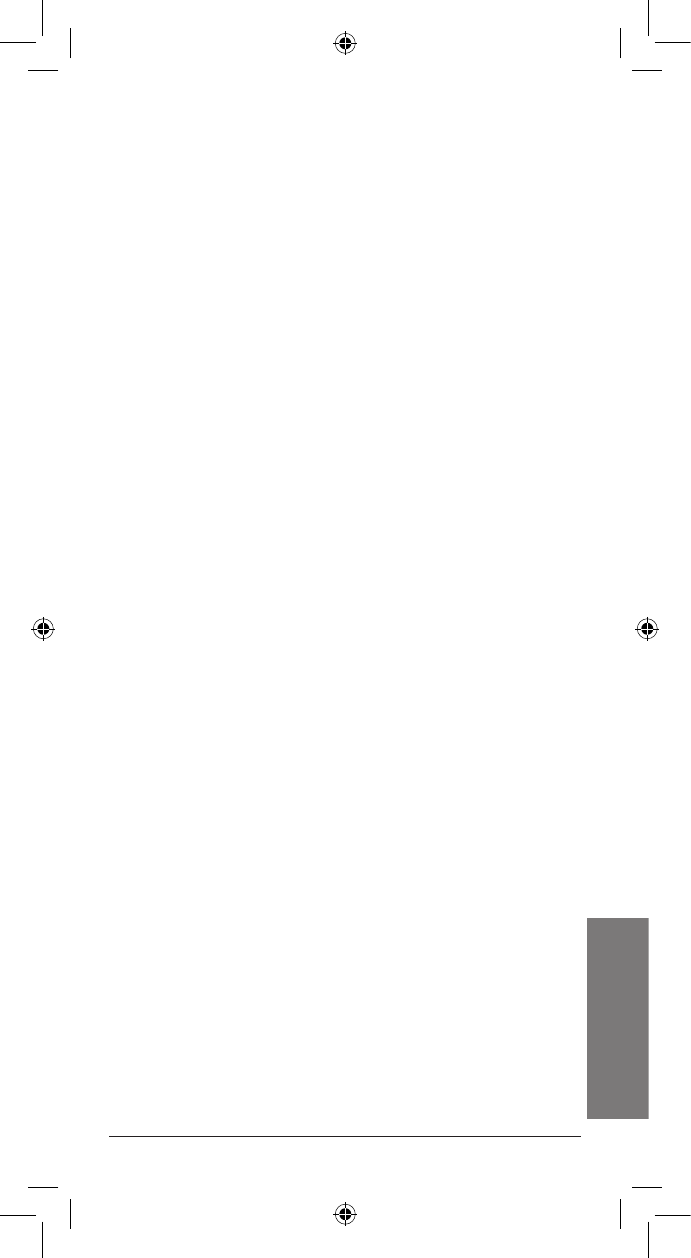
39
Additional Info
Limited Warranty
RadioShack warrants this product against defects in materials and
workmanship under normal use by the original purchaser for one
(1) year after the date of purchase from a RadioShack-owned store
or an authorized RadioShack franchisee or dealer. RADIOSHACK
MAKES NO OTHER EXPRESS WARRANTIES.
This warranty does not cover: (a) damage or failure caused by
or attributable to abuse, misuse, failure to follow instructions,
improper installation or maintenance, alteration, accident, Acts of
God (such as floods or lightning), or excess voltage or current; (b)
improper or incorrectly performed repairs by persons who are not
a RadioShack Authorized Service Facility; (c) consumables such as
fuses or batteries; (d) ordinary wear and tear or cosmetic damage;
(e) transportation, shipping or insurance costs; (f) costs of product
removal, installation, set-up service, adjustment or reinstallation; and
(g) claims by persons other than the original purchaser.
Should a problem occur that is covered by this warranty, take the
product and the RadioShack sales receipt as proof of purchase
date to any RadioShack store in the U.S. RadioShack will, at its
option, unless otherwise provided by law: (a) repair the product
without charge for parts and labor; (b) replace the product with the
same or a comparable product; or (c) refund the purchase price.
All replaced parts and products, and products on which a refund is
made, become the property of RadioShack. New or reconditioned
parts and products may be used in the performance of warranty
service. Repaired or replaced parts and products are warranted for
the remainder of the original warranty period. You will be charged
for repair or replacement of the product made after the expiration of
the warranty period.
RADIOSHACK EXPRESSLY DISCLAIMS ALL WARRANTIES AND
CONDITIONS NOT STATED IN THIS LIMITED WARRANTY.
ANY IMPLIED WARRANTIES THAT MAY BE IMPOSED BY LAW,
INCLUDING THE IMPLIED WARRANTY OF MERCHANTABILITY
AND, IF APPLICABLE, THE IMPLIED WARRANTY OF FITNESS FOR
A PARTICULAR PURPOSE, SHALL EXPIRE ON THE EXPIRATION OF
THE STATED WARRANTY PERIOD.
EXCEPT AS DESCRIBED ABOVE, RADIOSHACK SHALL HAVE
NO LIABILITY OR RESPONSIBILITY TO THE PURCHASER OF THE
PRODUCT OR ANY OTHER PERSON OR ENTITY WITH RESPECT
TO ANY LIABILITY, LOSS OR DAMAGE CAUSED DIRECTLY OR
INDIRECTLY BY USE OR PERFORMANCE OF THE PRODUCT OR
ARISING OUT OF ANY BREACH OF THIS WARRANTY, INCLUD-
ING, BUT NOT LIMITED TO, ANY DAMAGES RESULTING FROM
INCONVENIENCE AND ANY LOSS OF TIME, DATA, PROPERTY,
REVENUE, OR PROFIT AND ANY INDIRECT, SPECIAL, INCIDENTAL,
OR CONSEQUENTIAL DAMAGES, EVEN IF RADIOSHACK HAS
BEEN ADVISED OF THE POSSIBILITY OF SUCH DAMAGES.
Some States do not allow limitations on how long an implied war-
ranty lasts or the exclusion or limitation of incidental or consequen-
tial damages, so the above limitations or exclusions may not apply to
you. This warranty gives you specific legal rights, and you may also
have other rights which vary from State to State. You may contact
RadioShack at:
RadioShack Customer Relations
300 RadioShack Circle, Fort Worth, TX 76102 04/08
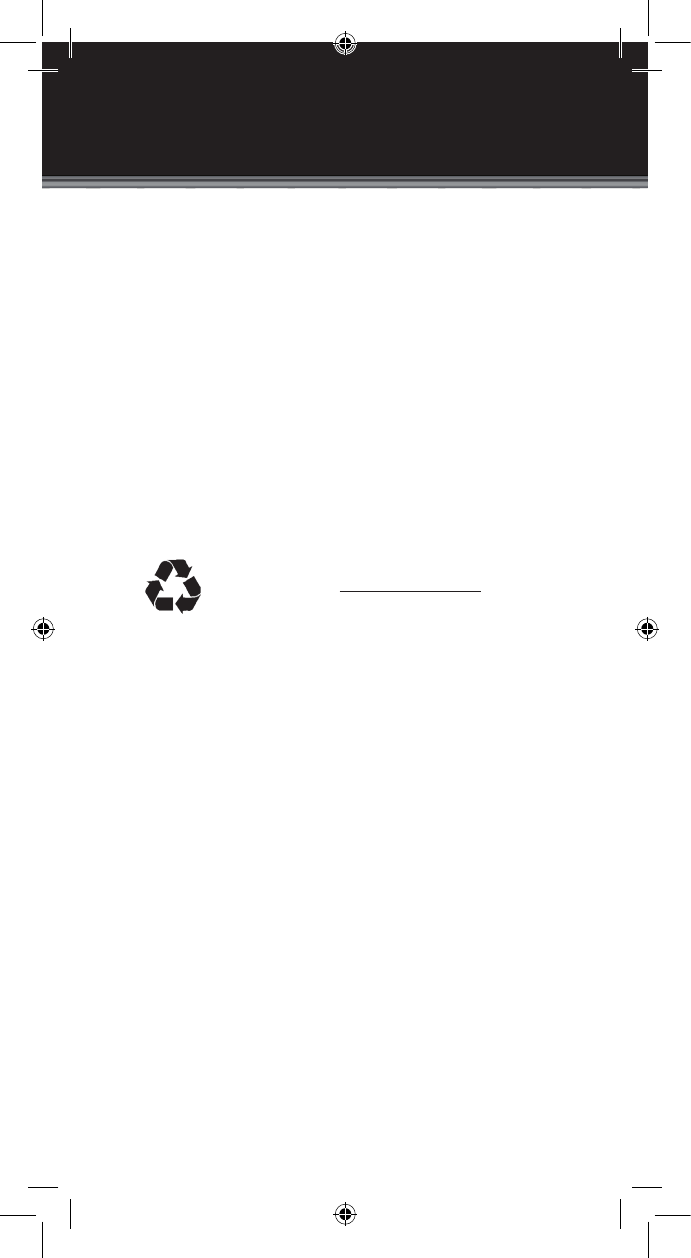
©2009. RadioShack Corporation. All rights reserved. RadioShack and
RadioShack.com are trademarks used by RadioShack Corporation.
Protect the environment by recycling your used
electronics. Go to E-CyclingCentral.com to find
an electronic recycling center near you.